with 🎙️ Florian Heeb & Julian Kölbel – Researchers @ the Center for Sustainable Finance and Private Wealth (CSP) in Zürich
💧 CSP is an academic research and teaching institution at the Department of Banking and Finance at the University of Zurich.
This episode is part of my series on Water Finance. Check it out! 😀
What we covered:
🍏 The two types of Impact – and what Impact Investing can trigger
🍏 How Impact Investing can grow green companies
🍏 How Sustainable Finance can make Brown Companies Greener
🍏 How Impact Investors can act as activists for change
🍏 How the tobacco example reminds us that screening strategies are limited by the barriers to change
🍏 How there are always sin stock funds to counterbalance green stock funds – and how those perform unfortunately stupidly well
🍏 How impact investing worldwide is still of the same magnitude as subsidies to the Fossil Fuel Sector
🍏 How the recent Swiss referendum on CO2 law, ignited by a fossil fuel companies industrial group, proves that there is still a long way to go
🍏 How pension funds could leverage their long-term positions in companies to foster an attitude change towards regulation
🍏 How diversification across the three mechanisms probably offers the best yield
🍏 Creating a special water activist fund, accelerating early water companies’ growth, creating new business models, taking risks… and much more!
🔥 … and of course, we concluded with the 𝙧𝙖𝙥𝙞𝙙 𝙛𝙞𝙧𝙚 𝙦𝙪𝙚𝙨𝙩𝙞𝙤𝙣𝙨 🔥
Teaser:
Resources:
➡️ Send your warm regards to Florian on LinkedIn
➡️ Then do the same with Julian on LinkedIn as well

is on Linkedin ➡️
Infographic: Impact Investing
LinkedIn-Infographic-HighTable of contents
- What we covered:
- Teaser:
- Resources:
- Infographic: Impact Investing
- Full Transcript:
- It all started with environmental studies
- Zürich’s Center for Sustainable Finance
- What is Impact Investing?
- Who can have impact?
- The two layers of Impact: Company Impact & Investor Impact
- How can Finance have Impact?
- Could 8% of Impact Investing really solve Climate Change?
- Is “step by step” the path to victory?
- What is the strength of Impact Investing compared with Sin Funds?
- Sustainable Investing can not save the World alone!
- Third mechanism of Impact Investing: Activism
- What is the strongest mechanism Impact Investing can use to do good?
- Is Finance sufficiently supporting the Water Industry?
- Rapid fire questions:
- What’s your favorite part of your current job?
- What is the trend that you see, which we should watch out in the water industry?
- What is the thing you care about the most when you start on a new project and what is the one you care the least about?
- Do you have sources to recommend, to keep up with the latest trends?
- Would you have someone to recommend me that I should definitely invite on that same microphone?
- Last thought? Let’s create a Water Impact Investing Fund!
- Other Episodes:
Full Transcript:
These are computer-generated, so expect some typos 🙂
Antoine Walter:
Hi Florian, Hi, Julian. Welcome to the show! So we were discussing just before launching this recording. And I was telling you that when you do something about finance, you expect people to come from Zurich. At least if you’re in Europe! And I was wondering if that’s a coincidence if both of you are sitting in Zurich right now, or if it was on purpose that you came into the center for finance, at least in Switzerland,
Florian Heeb:
I think it’s, it’s both a coincidence and not. I think we didn’t come on purpose to “the city of finance.” But we came both to study environmental science at ETH. Then I would say that the fact that we are still here, that’s no coincidence. We are working at the Center for sustainable finance and private wealth at the university of Zürich. And I think there are many reasons why that is in Zürich, kind of a hotspot of private wealth, development and finance in Europe.
It all started with environmental studies
Antoine Walter:
But so you both came to study environmental topics? Was that your entry point?
Julian Kölbel:
That’s how we got to know each other, yes. 12 years, 15 years ago. I forgot that.
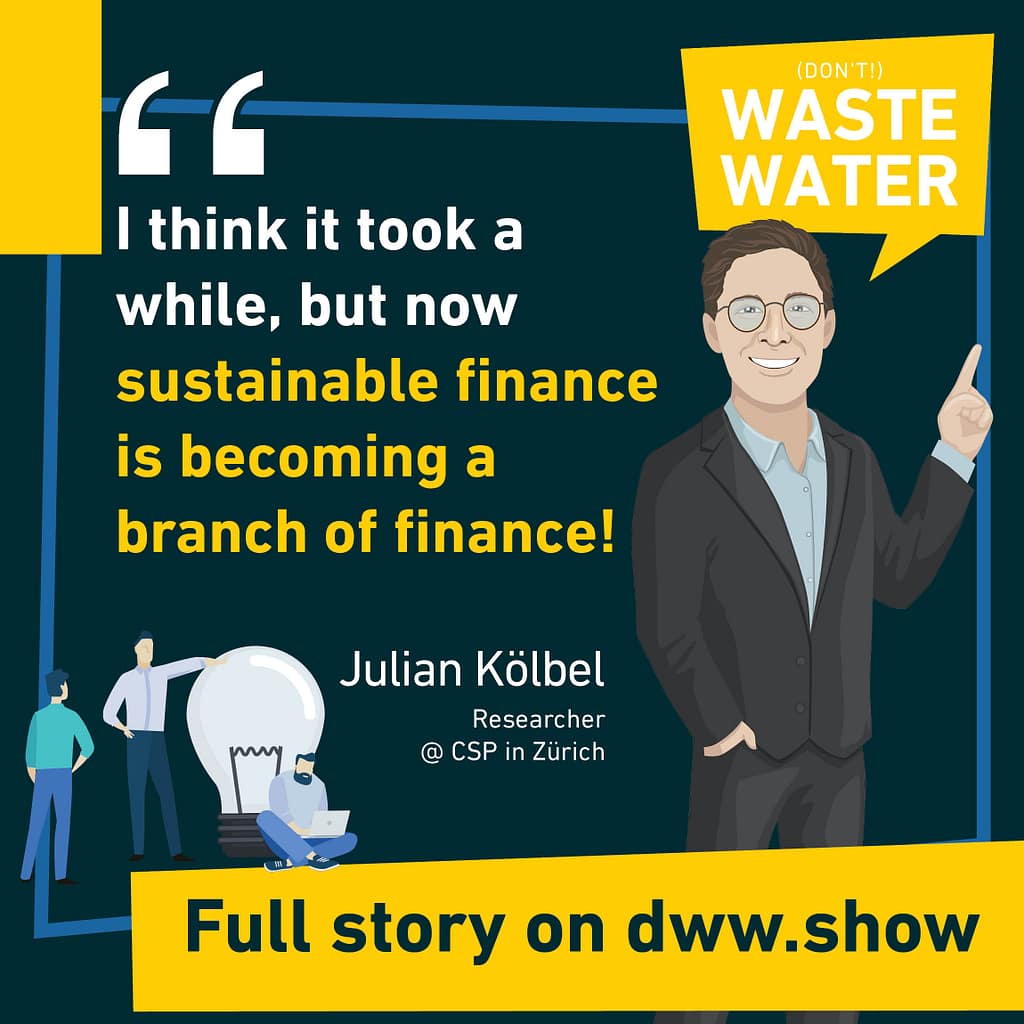
Antoine Walter:
And how, starting with such a pure endeavor of solving the environments, do you come with this weird Idea to turn to finance?
Julian Kölbel
Well, I think it’s, for me it really started with ecology and, you know, you have these concepts of competition in ecology, and I started thinking also that the word itself, ecology and economy, is kind of the study of the house and the management of the house. And, and that all got me thinking, you know, how does this work together? Because we’re somehow part of the planet, everything that humans do.
And then, you know, once you start thinking about things you go further and further. There was a job I had at rep risk which is a data provider where they basically collect all the negative news about companies in terms of the environment and also social issues and make a score out of that.
And I was thinking, well, that could be really powerful in terms of addressing the environmental problems we have, if we just have a system where the financial markets which is this big machine that somehow drives a lot of what happens on the planet takes into consideration environmental information.
And that’s the basic idea that draw me towards looking into sustainable finance. Of course, we’re both not sort of pure finance guys. We do this sustainable finance, and we’re excited about that idea and whether that works,
Zürich’s Center for Sustainable Finance
Antoine Walter:
Is it different finance and sustainable finance is it really two different fields or is it a specialization within finance?
Julian Kölbel
Well, I would say it’s you know, it’s blending. It’s often that fields, that have nothing to do with each other at some point start to overlap. And yes, I think it took a while, but now I would say that sustainable finance is becoming a branch of finance.
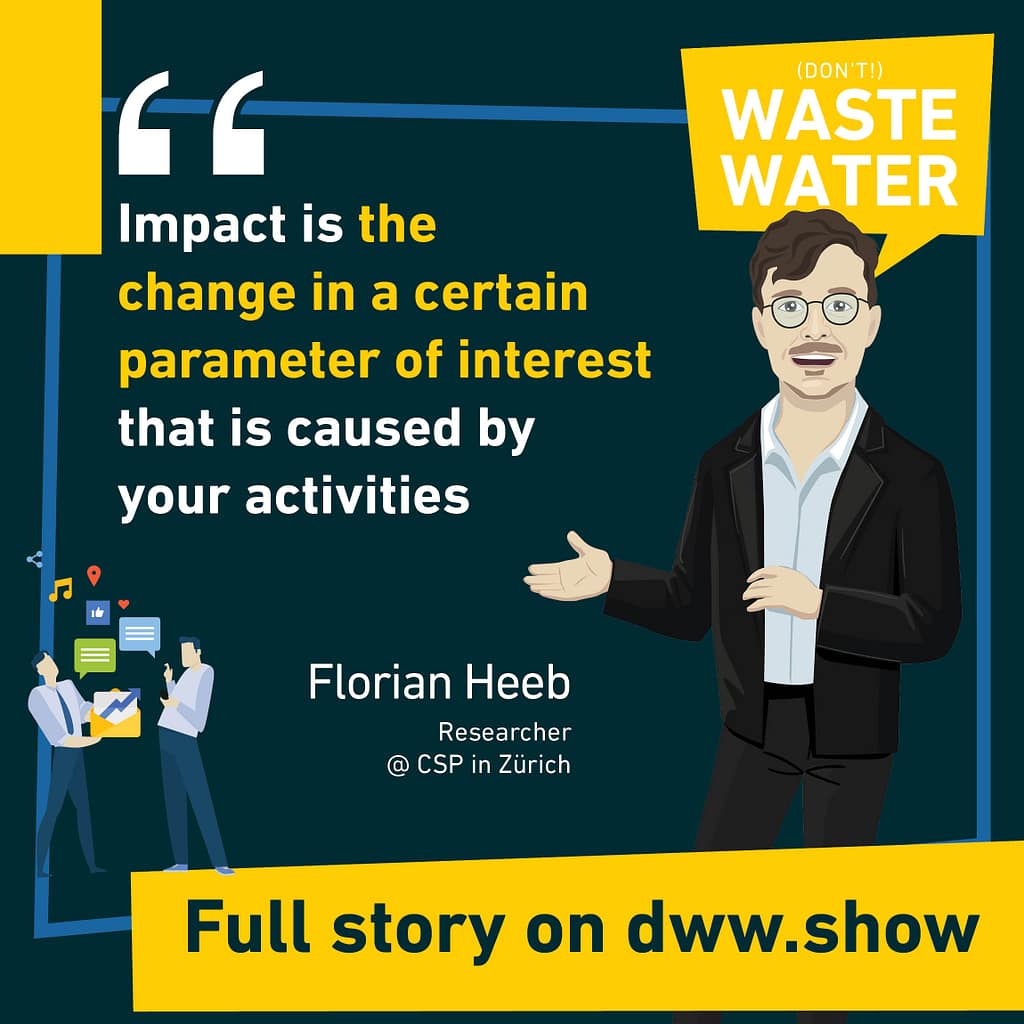
Antoine Walter:
You’re both into the center for sustainable finance in Zurich. And I saw that it’s not that long that this center exists. If I’m right. It was created around 2015, 2016. So is it because it’s an emerging trend and an emerging matter, or is it just because it wasn’t existing Zurich before and now it exists?
Florian Heeb:
I think it has a very specific history. So it all started off with the founder, Falko Paetzold and some other people launching a program at Harvard University for ultra-high network next-gen. So kind of the next generation of these super rich families, kind of helping them to get started with impact investing. So there’s many very motivated people there, but they like the basics and out of this program came the idea that we need an academic center to do research on how to have an impact. How to actually move the needle of if money. And that’s, that’s how it at the central sustainable finance at university of Zürich was then founded.
What is Impact Investing?
Antoine Walter:
Actually you cracked the big name: impact. That is a topic that we addressed, or we scratched the surface, a couple of times on that microphone. I think, especially of a discussion I had with Kimberly Baker, from the elemental excellerator, or a bit more recently with Nicola Lei Ravello from White Stag investing. But I realized when I was preparing this discussion, we are having together, the three of us that we never really defined what impact means. Impact in general, and then impact investing. What’s going to be your definition of that word?
Florian Heeb:
I mean, I think that’s an excellent question. I think one that gets asked very too little. Julian and I have our own definition of impact that we use in our academic work, which is that impact is the change in a certain parameter of interest, for example, clean drinking water that is caused by your activities.
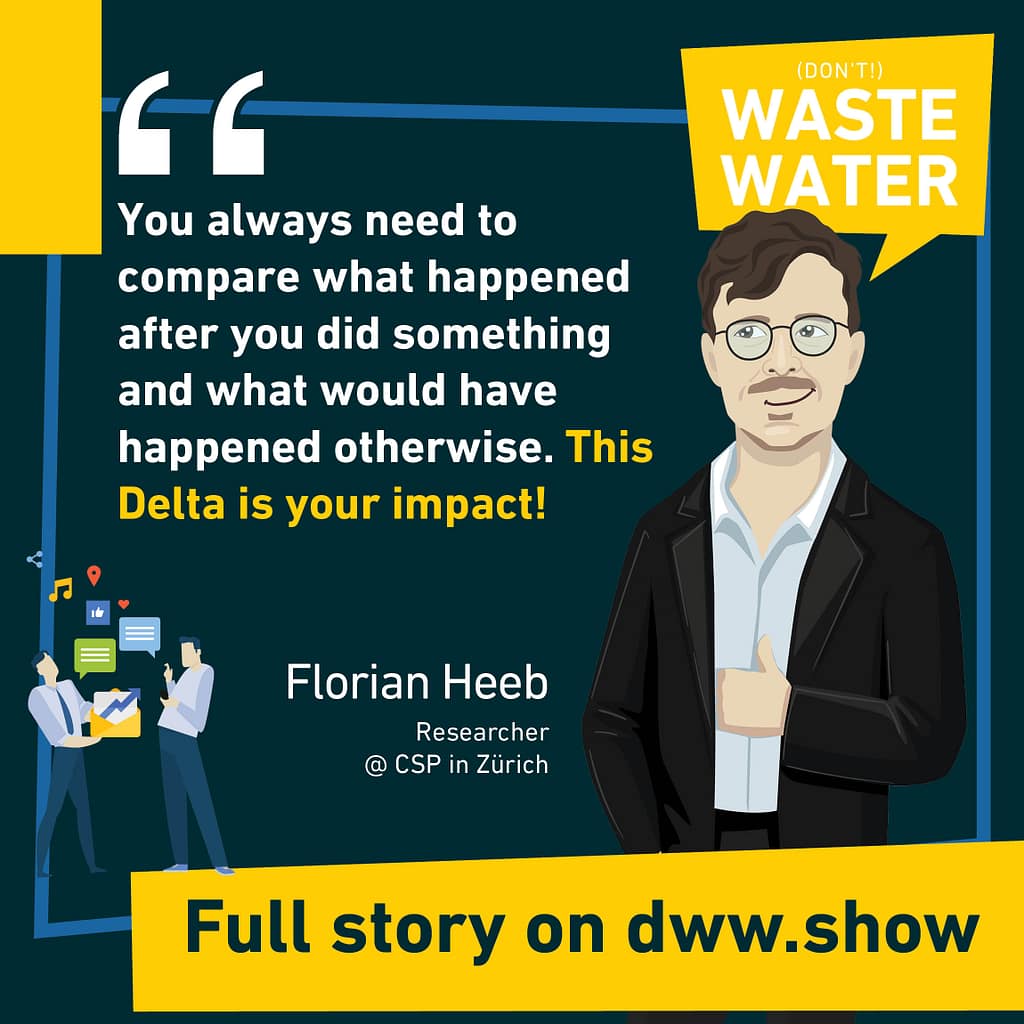
And I think that that sounds a bit trivial, but it has some very specific components that are rather tricky. So first of all, something has to change. So you have to observe some change in the real world.
I mean, this is a water podcast that could be, as I said, clean drinking water that could be, you know, water quality in a certain lake or whatever. I think that the hard part is, is the cause, that your activity causes something. So, and that’s quite hard to assess.
So you would need to think of what would have happened without your activity. What did your activity cause above and beyond what would have happened otherwise without your activity? So often this is called, you know, the counterfactual or the baseline or additionality of an action. So you always need to compare kind of what happened after you did something and what would have happened otherwise, and only above this kind of Delta that you have there, that’s your impact.
Who can have impact?
Antoine Walter:
When you mentioned this activity, who is active? Is it the company itself? Is it the investor, is it a combination of both?
Julian Kölbel
Well, I would say that’s, that’s actually very general. So whoever has activities, you know, lined up in front of her or him to choose from, and that’s the situation where you would think about impact and at some level, it’s very simple.
You want fresh air in the room. So one option is you open the window. Then you open the window and you have fresh air. So you had an impact on the climate, in your room. These are the simple cases. But the basic concept extends to more complicated cases.
So first of all you know, when we think about companies that operate in some social context, like, let’s say access to drinking water is, is the concern that the company is a business, like a brewery that actually uses a lot of water, fresh water and exports it away to other places.
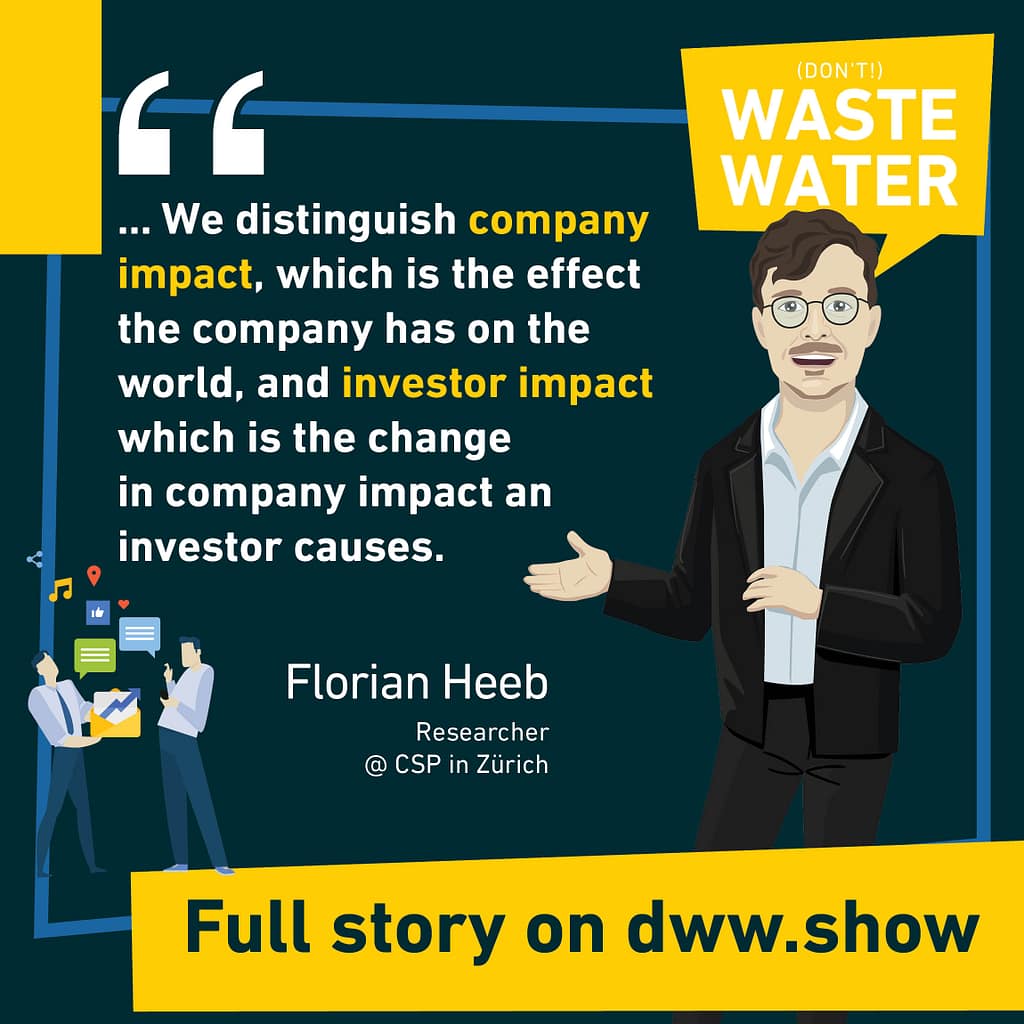
So, so as this company, you should, you know, what are your options that you can do to somehow be part of the solution that all the people that live around your factory also have enough water, right?
There’s a range of things that you could do. You could hand it out directly, you could use less water, you could lobby the regulator and sort of improve the overall water management of the basin.
There’s many options and it’s a tricky problem, and it’s not clear what is the most impactful action, but I think the problem is the same. You have a target – I’m making this up, right – but the target might be okay. We want everyone in this valley to have, you know, these 25 liters, minimum of clean drinking, water, safe in your house. You know, and how do we reach that?
And then you can think of what are your options? What can you contribute towards that goal? I think that’s the essence of having impact thinking along those lines.
And then if you’re an investor, there’s an additional step. I think maybe that’s where you want to go.
The two layers of Impact: Company Impact & Investor Impact
Florian Heeb:
As, Julian, already explained, I think figuring out what the effect of a company on the world is, is quite a tricky endeavor in itself. But what stood out to us when we started research on the impact of sustainable investing is that we have two steps.
I mean, with investing, it gets even more complicated because obviously, you need to know what the companies you’re investing in are doing in the world. But more importantly, I would even say, you need to figure out what your effect as an investor is on this company.
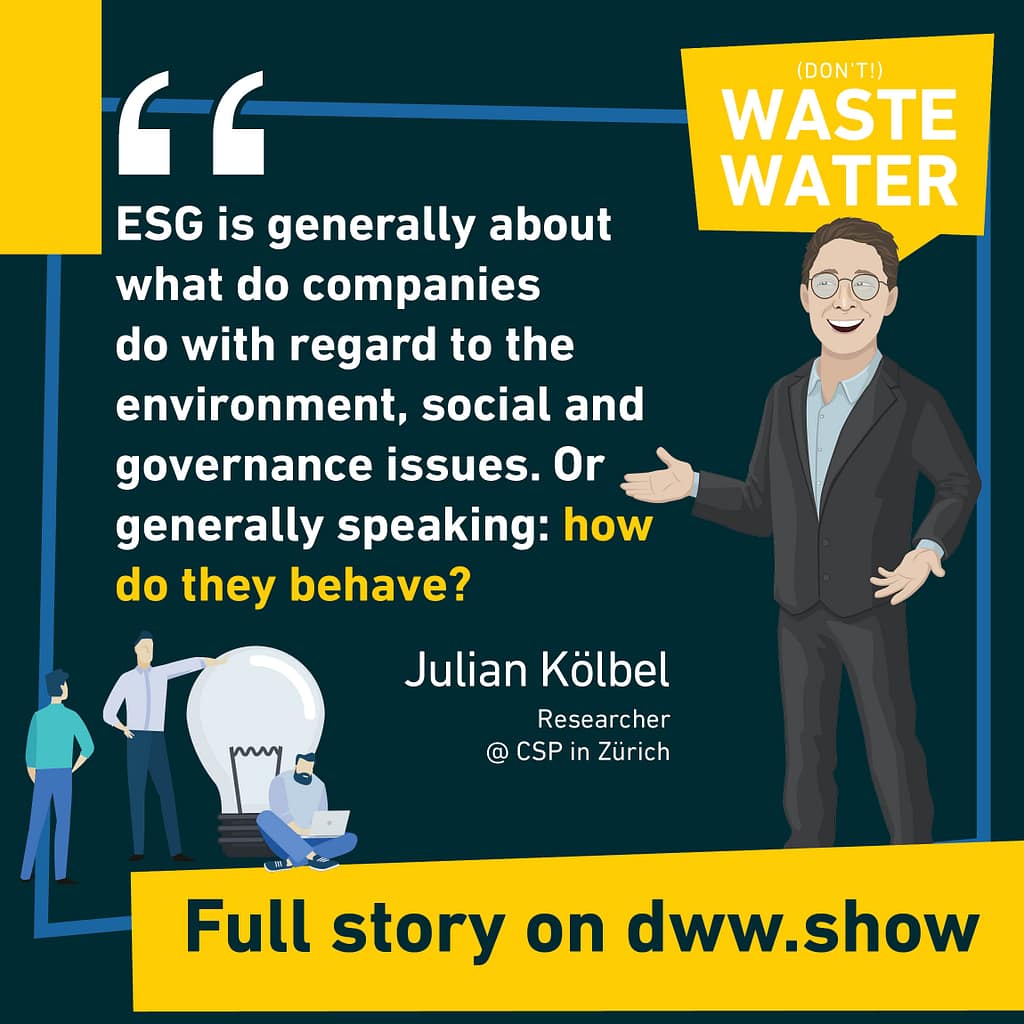
So if you take this brewery, you know, how do you contribute to, or change what this company is doing?
So that’s why we came up with the definition of impact, you know. That’s how we provide this definition that sounds maybe a bit wordy and complicated, but in terms of investing, we have a very clear definition of what your impact as an investor is.
So we define company impact, which is the effect the company has on the world, on any given parameter of interest. And investor impact, which is kind of the change in company impact an investor causes. So I think it’s very helpful to distinguish between these two layers and that’s something that’s over often overlooked.
What is ESG?
Antoine Walter:
When we speak of company impact, there is another acronym that comes quite regularly. It’s this ESG. Can you just – and then when we’re done with the housekeeping and we can go to the deep dive – can you define these ESG? And all these things usually work by three, so we have ESG, but we have also the triple bottom. So these economic, social and environmental factors. And I was wondering if there’s a difference between those two, as we talk about sustainable investing and we talk about ESG. And is that exactly the same thing or are there some nuances between those two different concepts?
Julian Kölbel
I would say rather than nuances there’s general vagueness and that’s natural, you know, so I don’t say this with, with evil intention.
The ESG is generally about what do companies do with regard to the environment, social issues, governance issues, sort of the, generally the question, you know, how do they behave?
And then it’s natural that this becomes vague because then what are all the social issues we care about? You know, child labor, perhaps. Water is half an environmental, half a social issue. How do we measure them? You know, how important are they relative to each other? So, so that all those questions make it difficult and vague what exactly is ESG and SDG.
And that’s a problem. How do you sort of come up with sound ways of assessing that?
But I think what’s very clear is that ESG triple bottom line, it’s about the company and it’s generally, you know, it can be about company impact.
That’s generally what it addresses. And investor impact is then something that comes on top sort of, you could look at the change in ESG as a sort of rough proxy, right. But simply saying, and this is what we sort of try to make very clear is that you just simply say, well, here’s a company with good ESG rating, I invested. Hence I, as an investor have changed the world. I think that is a statement we would always counsel to avoid because it’s wrong.
How objective are ESG Rating?
Antoine Walter:
If I was to play the devil’s advocate now, just for, for, for one minute, you gave us now some elements you say ESG might be vague because everyone can a bit see what he wants to see in this ESG. And you also said ESG rating. If I’m a company that wants to paint itself green, I can use my own rating and be wonderful. And by another kind of angle, I might be a bit less good. Do you think, this is one of the reasons why it’s a bit vague it’s because that way everyone can create his own rules or I’m a really looking at things with now a very negative view?
Florian Heeb:
I think one point, I think you have to say, I think these ESG ratings, I think that they were born kind of, mainly of out of the risk perspective, the financial markets have learned that there is the concept of risks in many ways.
And I think the early 2000’s, came this perception that there’s also, you know, material, environmental, social risks. So these metrics were used to measure these kinds of risks.
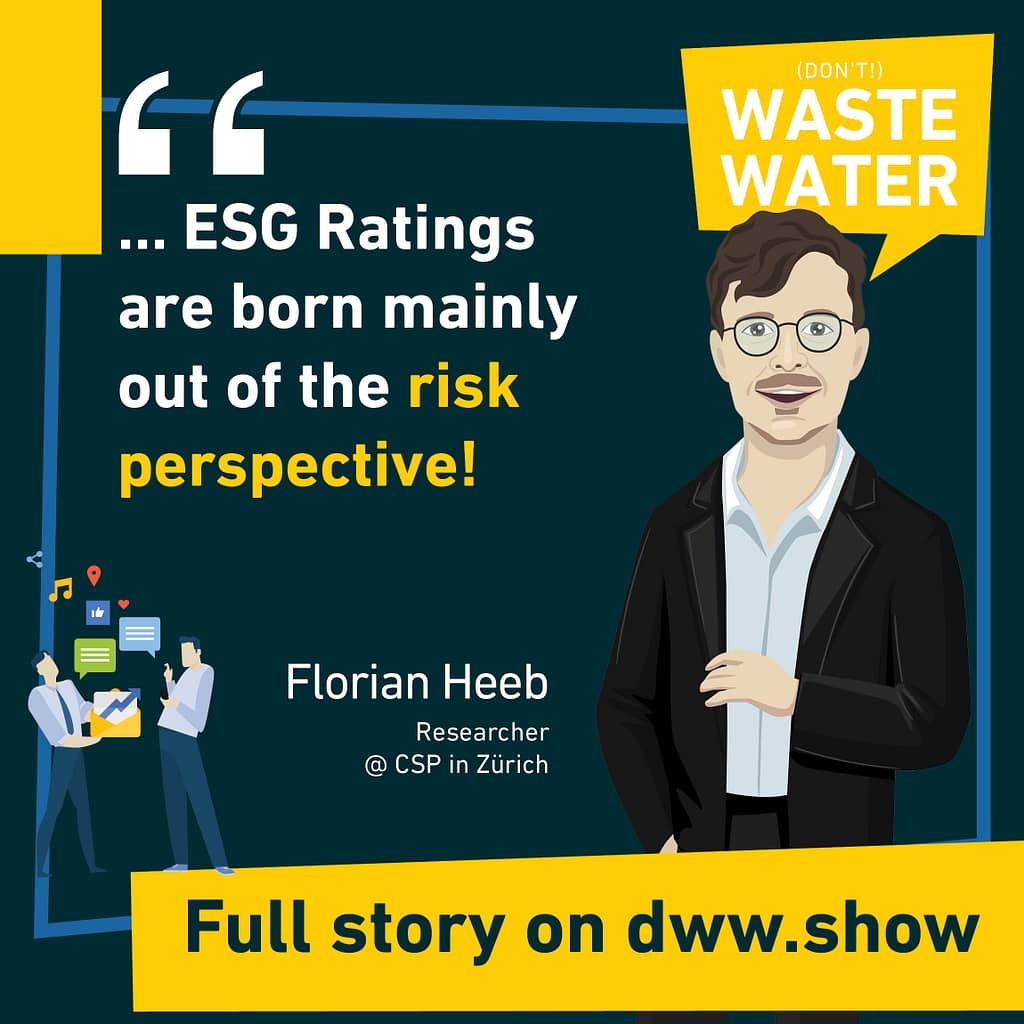
I mean, how likely is, you know, the companies getting sued because of some social problems they have or you know, that they cause environmental disasters and so on. So I think, that’s maybe one point we have to realize, that ESG is not necessarily seeing how green the company is, but kind of how it manages its, its environmental risks. But I think Julian has many things to say on how to measure ESG ratings and the problems with that.
The limits of ESG Ratings and why Impact shall be used instead
Julian Kölbel
We did a study called aggregate confusion, the divergence of ESG rating. So it’s a topic that I’ve been working on quite a bit with colleagues at MIT.
And yet, it’s natural that you come to different conclusions because it’s such a multifaceted issue that you’re considering, right. ESG alone environment, social governance are three vast topics. What are the criteria within those topics that you look at? How do you weigh them? How do you measure them? These are all questions that aren’t clear. I mean, it’s not obvious how you will do that.
It’s on the one hand natural that different providers come up with different ways of doing this and it has grown historically on the other hand, as you rightly point out, it does also cause problems then.
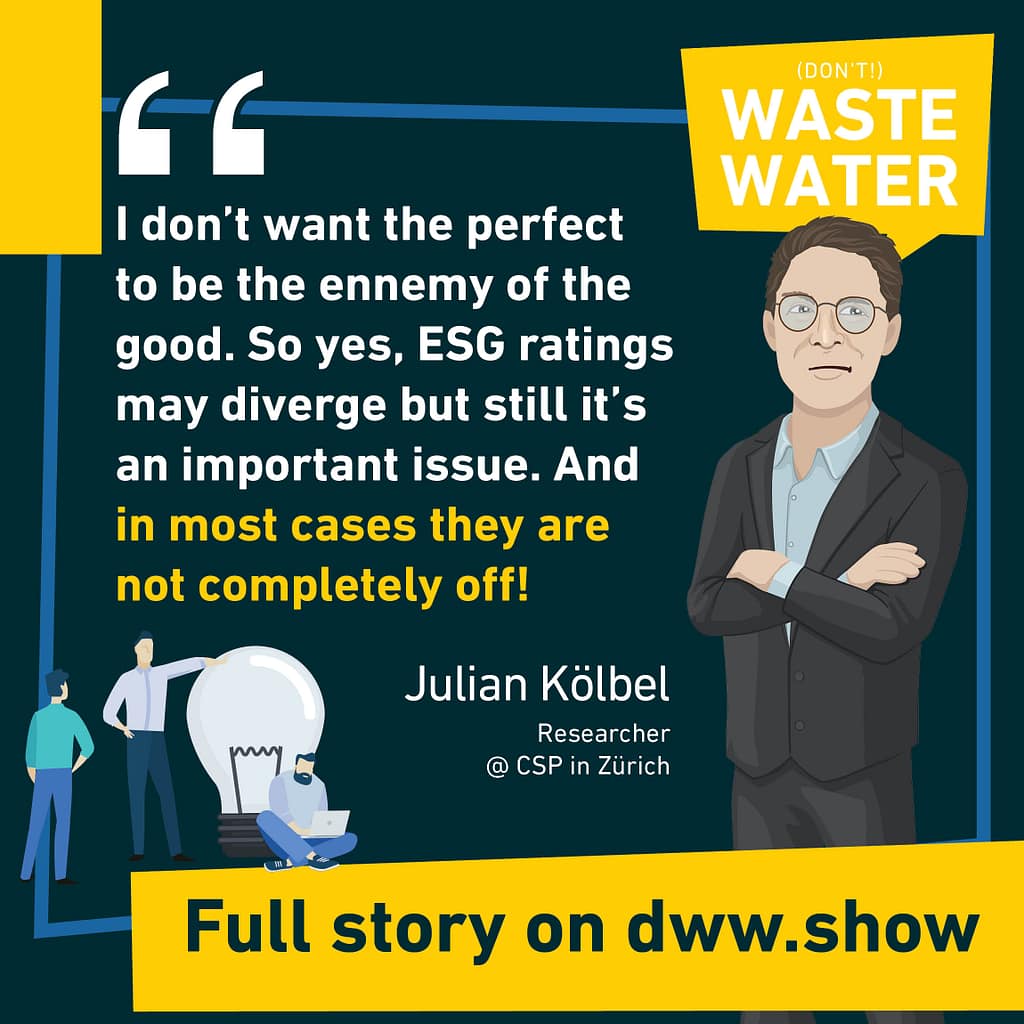
And I think the most severe problem is actually at the company level where a company says, okay, let’s become, a really good company but they also want to be rewarded for that. So they want to then look good and the ratings and it’s, it’s difficult to figure out how you do that.
So there’s really a measurement problem here. But I think, you know, I don’t want the perfect be the enemy of the good, so yes, we say they diverge, but still, you know, it’s an important issue.
And they’re also in most cases not completely off. Right? So it is an helpful data point. You just have to be aware that there is some, you know, that there is some uncertainty left if you use these metrics.
Then impact if I may transition, right. Sort of ESG was kind of the, I would say the past has been a lot about ESG and as Florian said, focused on risks. And I think this impact story is becoming way more important now. And that basically means often that you try to tie everything to SDGs, to the sustainable development goals, and that’s a trend that I see happening right now,
Impact, ESG, SDGs… What next?
Antoine Walter:
First, it’s a very valid point you make. It’s something we discussed with Paul O’Callagan on that microphone, where he was explaining that good enough approaches might solve much more than always to say that better and better and better and perfect can be achieved.
Done is better than perfect! So I fully subscribe to what you just explained. You, you alluded now to the UN SDGs, which is something, you’re right, which is in all the conversations, is it something new or is it a clever way that we’ve put on the table to just measure what we have to achieve in which direction we have to go?
I mean, in the water sector, we all now talk about SDG6 to a point, which is maybe even over the top. I mean, there’s no single company speech that doesn’t include how we are leaning towards the SDG6, whereas one can argue that we are doing many stuff in the day and that probably not 100% of it is going into this SDG6 direction. So is that again, another concept? So we would have impact, ESG, SDG, and maybe by the next calendar of the United nations, there’s, there’s a new acronym or is it like a marketing tool? How would you see that SDG element?
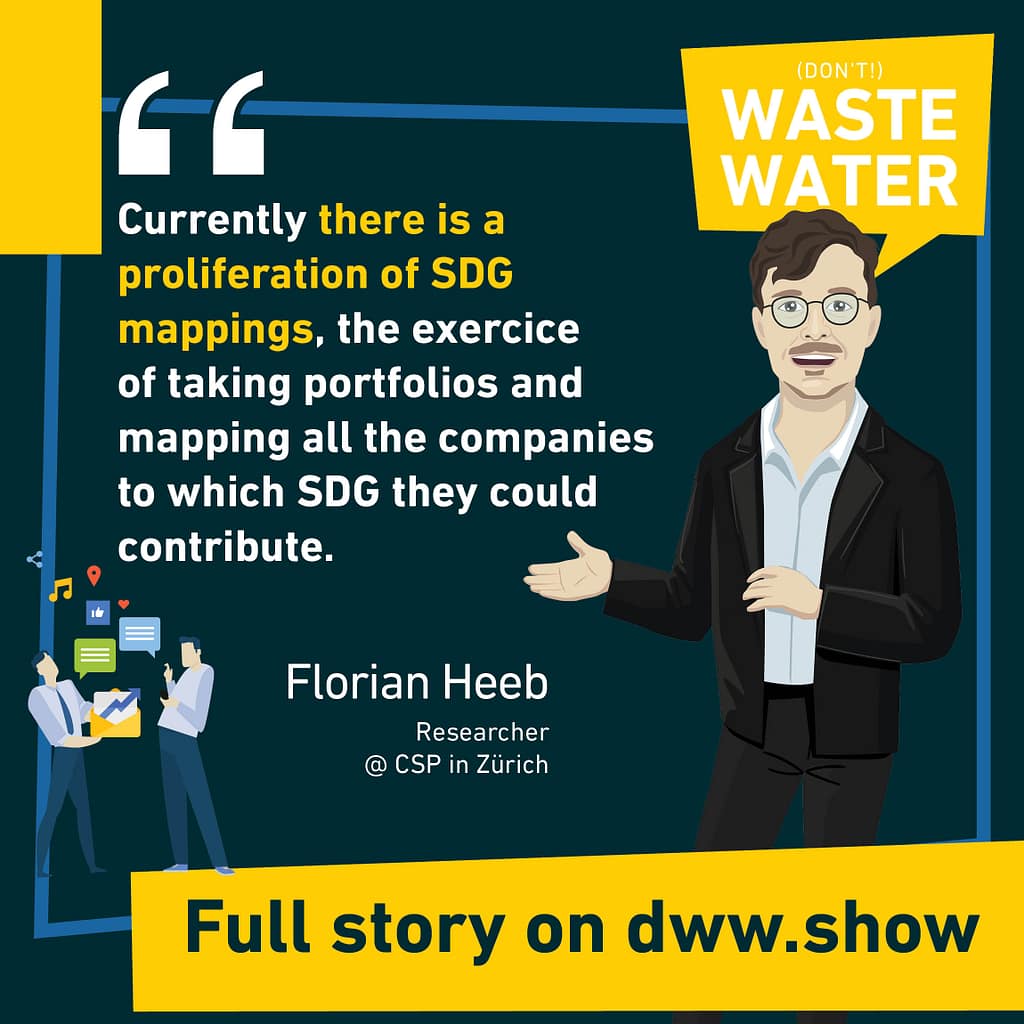
Florian Heeb:
I think it has all the aspects you’ve just mentioned. I think, first of all, I mean, we said, you know, impact is changing the parameter. So we have one problem. I mean, there’s like thousands of people out there with thousands views on what should be changed in which direction. So there, the SDGs really helped. They provide, you know, a global common view on where the developed world should move and, and that’s something you can use to, you know, to track impact.
I mean, are you making progress towards, you know, commonly agreed, clearly defined targets. So I think in this, these aspects, certainly I think thing SDGs will remain. And then what we see in the finance world is that the SDGs they become really popular.
Currently, there is like a proliferation, I would even say of SDG mapping, you know, exercises of taking portfolios and mapping all the companies to which SDG they could contribute. But again, currently I see in this respect to two major issues that we need to work on.
So first of all, that’s also what we see in our research. You know, owning impactful companies is not the same thing as having an impact. So we often see that people mapped companies in their portfolios to, I don’t know, this company contributes to SDG6 or this other one contributes to many other SDGs.
So as we explained before, this is company impact at best, you know. This doesn’t explain, if you invest in that company, you don’t have, let’s say we have a company that really contributes to SDG6.
If you invest in the company, you don’t necessarily contribute to this impact or making them have more impact. But it, what it says is that you have exposure to SDG6. And I think these are really different concepts. I mean, it may be very valid if you, as an investor think, okay, “future lies in water” you know, there’s going to be a lot of more, you know, also regulation, issues, action, and so on, that pushes the water sector. So I want to have exposure, but that’s not the same as actually, you know, helping the world reaching the SDGs faster.
How can Finance have Impact?
Antoine Walter:
So let’s dig into that impact because I’m sorry, I sidetracked you a lot, but how can finance itself have an impact? We’ve seen how the company can have an impact. Let’s look at finance. What are the mechanisms that an investor can have to have impact on the company and hence be the tool of the market impact?
First mechanism of impact investing: Grow Green Companies
Julian Kölbel:
I think there are three major ways in which that works. The first one is there are companies that have a business model that, by what they do, have a positive impact on the world. Like, you know, let’s say a company that produces and distributes mosquito nets which are then important to prevent malaria. And even local employment. So that’s really a good idea if that company would grow.
And now sometimes companies, especially in developing markets have a problem, to tap into capital that allows them to grow. I mean, they can of course grow organically, but they could grow much faster with external financing.
Sometimes they don’t have that external financing. And then if you go in as an investor and you provide that external financing, then because of your investment, you know, there’s so many more mosquito nets distributed and that’s how you can have an impact: by growing companies doing something good, that do not have access to capital.
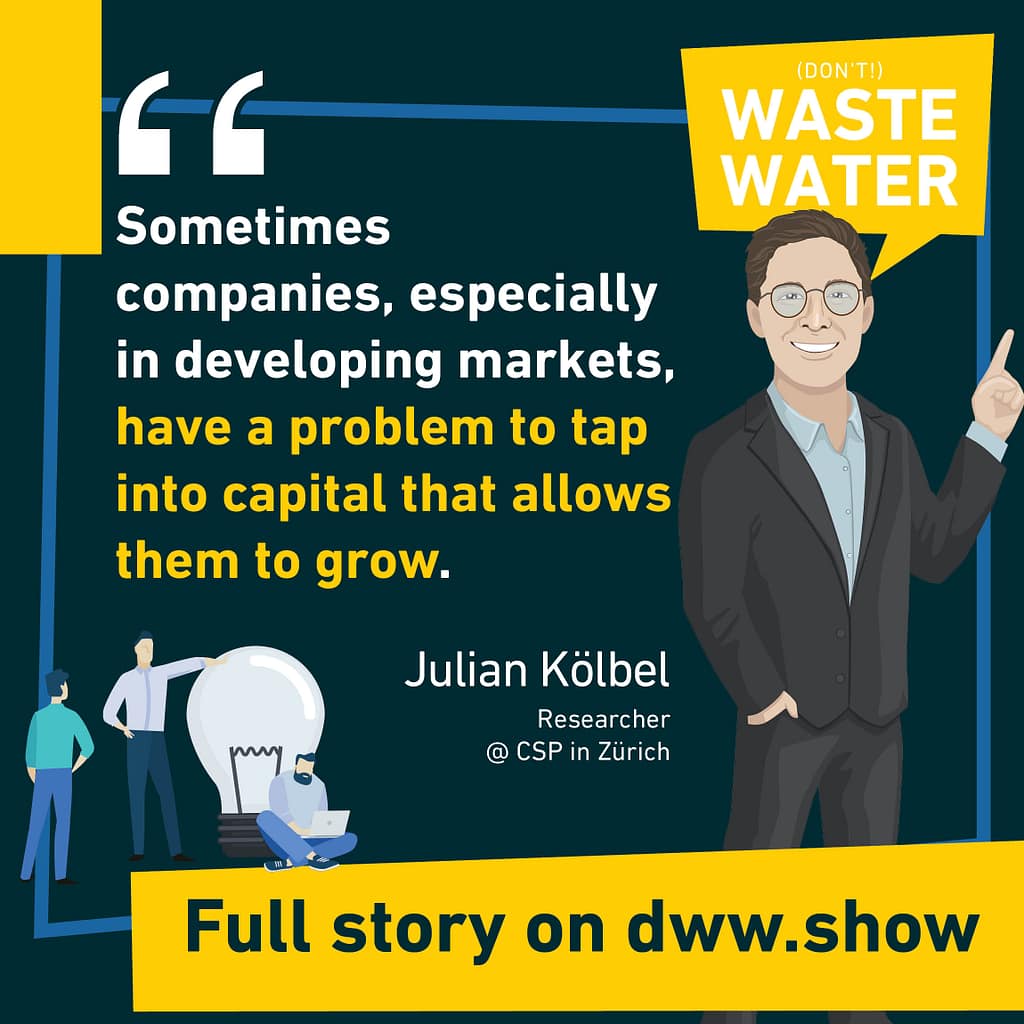
You can solve a problem here. And that’s a bit limited to small companies who actually need financing. Usually, that’s sort of pretty rare for larger companies, listed equities, and so forth. That’s also the classic impact investing space, smaller companies.
Antoine Walter:
So that’s the first mechanism at work: growing green companies. That’s the first lever. And you said there are three levers. So what, what would be lever number two?
Second lever of impact investing: Making Companies Greener
Florian Heeb
So basically first level we talked about, growing green companies, and then Julian already explained like the mosquito company for mosquito net company.
The second lever is making companies greener. So engage, as a shareholder, you own stocks. So you own part of the company. So you can engage with companies and try to change what they already do in a certain direction.
This growing in green companies is limited to places where there are financial frictions. Small companies, developing countries, emerging markets, and so on. Startups.
But there are also many spaces in large, big established companies where we really don’t see any evidence that, that by allocating your capital, you can change much in their growth path.
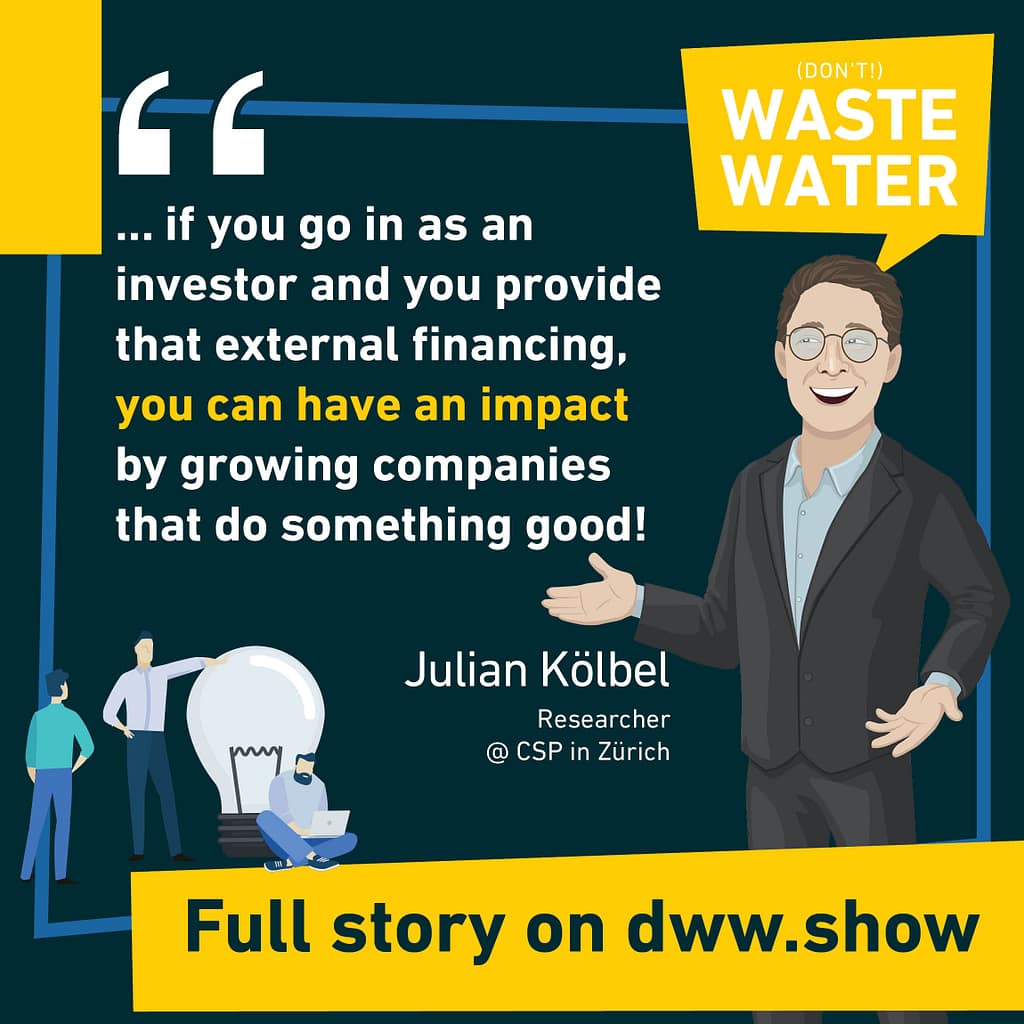
In these cases, there’s evidence that investors can change how green these companies are. So not how fast they grow, but how they go about their business. The options are for instance shareholder engagement.
Or really entering into a dialogue with the top management on how their environmental policy should look like, there’s voting. So you can, every shareholder in most countries can vote on shareholder resolutions. It’s a bit tricky depending on local legal systems, but you can vote.
And then we saw some impressive things. For example, with Exxon, just very lately that this is really a way to go. And obviously, as the third thing, there is really activist investing kind of investor schooling, taking stakes in the company, pushing a company going in one or the other direction.
So the second mechanism I would call it, making brown companies becoming greener, it maybe works best where companies are not the greenest to start with. So taking rather the laggards and then helping them to, to improve and taking the leader is already.
Could 8% of Impact Investing really solve Climate Change?
Antoine Walter:
On the second mechanism. There were many interesting stuff in your research paper, I just highlighted a couple of them just to be sure I understand it right. If I get your right it would take “only,” and I put brackets around the only 8% of sustainable investing in this capital allocation from brown to green to solve the climate challenges. Is that right?
Florian Heeb:
That paper is not our research, it is a study by Gollier and Pouget (2014). So here things get a bit tricky. I would say. We talked about two ways: giving capital companies to grow, then engaging with companies to change. Now, there’s also way another way, how you can make companies to change, but with capital allocation.
If you apply some rules saying, look, I only invest in companies that meet certain ESG levels or ESG standards that may provide incentives for companies to reach a standard. Because if you, if many investors allocate according to the same rule that will push up, share prices a little bit for these companies and then provide managers an incentive to actually adopt these standards.
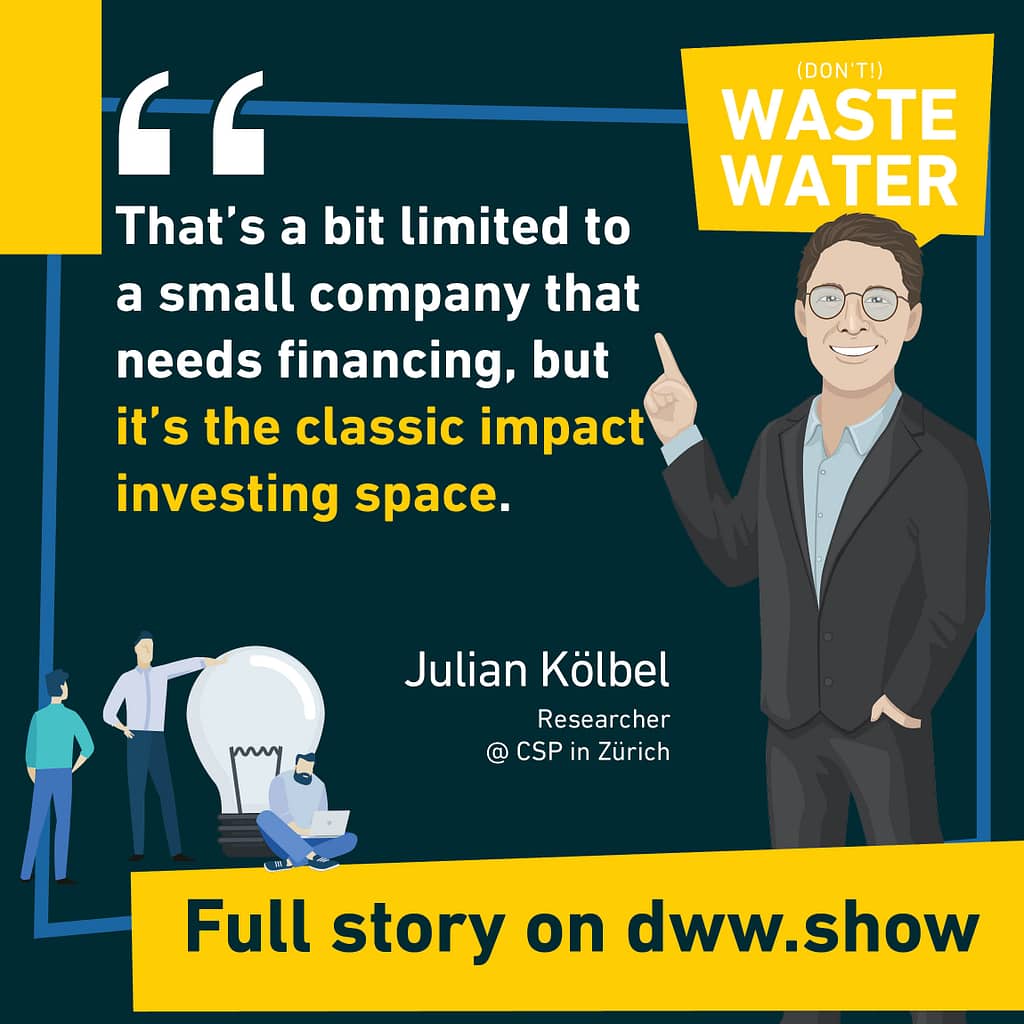
That’s the thinking behind and very recently, they have been a whole host of models by top-notch economists and going in this direction stating actually, if investors have environmental, social tastes, these should create incentives for companies to change.
These 8%, that’s just one model on under gave some assumptions that it comes to the conclusion. If 8% of investors would, you know, have some, some climate preferences, could companies, you know, make measures the cost them up to I think, 5% or something like that of the revenue to change.
Theoretically: Yes. Practically…
But I think what’s important here is these are all theoretical models. So the question is about what happens in the real world. And what I find striking is, you know, if you look at the real world, Switzerland just had a market report on sustainable finance.
I think 50% of all the funds apply some sustainability strategies in, you know, in their investment process. So if you look at that, you would assume that if you’re already far above these 8%, but somehow we still don’t see the change, you know, needed to, to move really, to reach the SDGs or solve climate change. So I think there’s this discrepancy between kind of this model, projections and what we see in the real world. That’s something also, if you’re doing research on,
Antoine Walter:
If I recall your research regarding this, this investment into sustainable sustainability from, from the investment funds, it’s also a matter of which comes a bit back to what we were saying in the beginning on the ESG ratings. If everyone has its own mechanism in a way to rate the market, you can have half of the investment funds having sustainable investing in their vision of the world and the way they work, but they might be pushing in opposite directions so that it may be counterproductive. I mean, what’s fund one is doing is balanced by what fund B is doing.
So that means if you don’t have a consistent grid, to read the word and to read the ESG impact, you can have all the people doing sustainable investing, but with their own glasses.
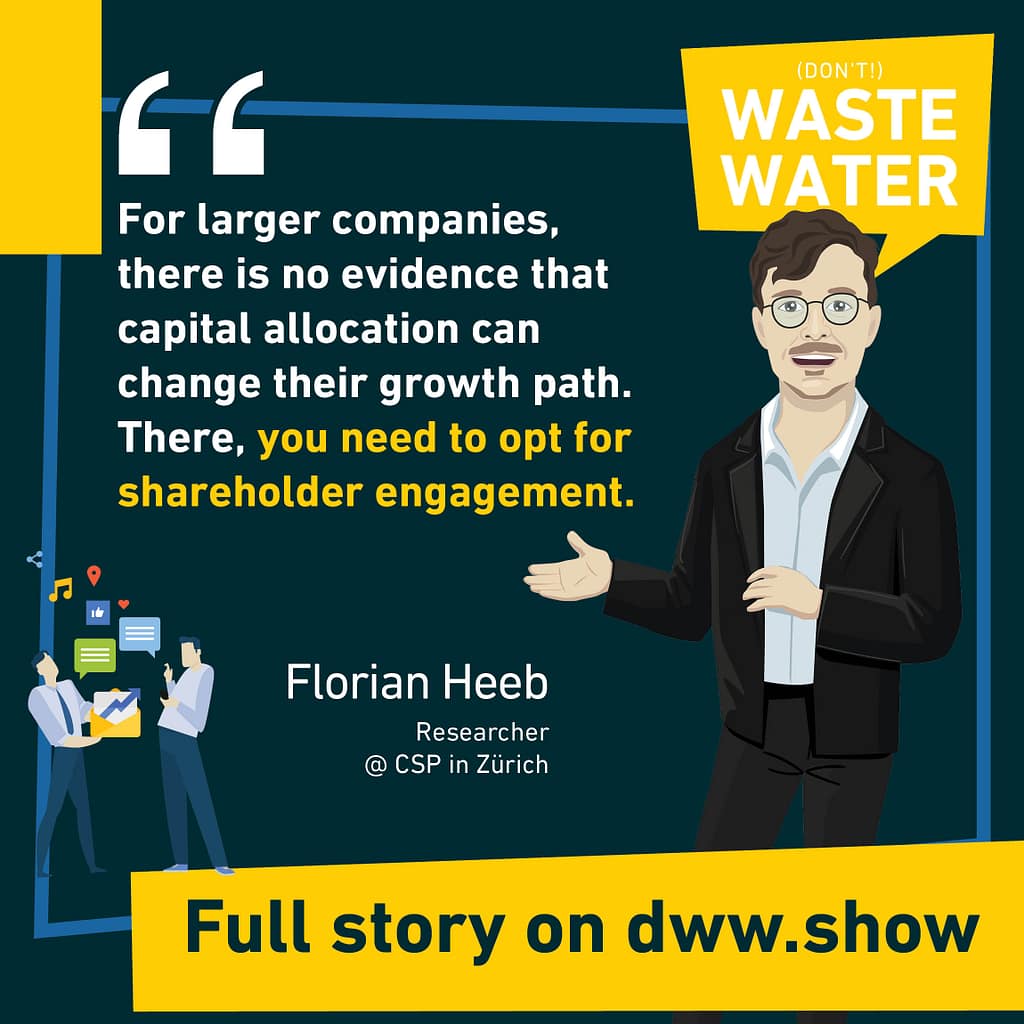
Julian Kölbel:
Yeah. That’s true that so disagreement about which firms are brown and green will weaken the effect. And I think these models acknowledged that usually, and there are models.
So this 8% statement basically says, well, if 8% of global investors, everyone, you know including all sovereign wealth funds would completely exclude fossil fuel companies, I think that’s what they mean. And that clearly is not the case.
There are fossil fuel divestments, but I don’t have the numbers, but I don’t think it’s anywhere near, this 8% of the global market. Now if it were to reach that point, I think in our research, we sort of identify two key things to think about. The one is, you know, how big will be the change in share price.
What can be the negative impact of Impact Investing on “Brown Companies”?
So you could imagine you know, the share price of Exxon, for example, to sort of deteriorate, you know, maybe by 5%, maybe 10%, maybe 50%, we don’t know. But that’s one important parameter to think about. And then the other one is what is the cost for Exxon, you know to become eligible again, for the big pool of green investors.
And basically then it’s a simple calculation. As soon as you sort of you know, you gain more in firm value by investing X dollars to become a different firm than the assumption goes, managers should do that. But our impression is that this doesn’t happen very much especially on the big tickets, right? So I think a good example to look at is tobacco. Tobacco is one of the most widely screened industry in sustainable investing.
And since a long time already. Most sustainability funds do not include the tobacco industry, but the cost, of course, for the tobacco firm to become a non-tobacco firm is absolutely prohibitive.
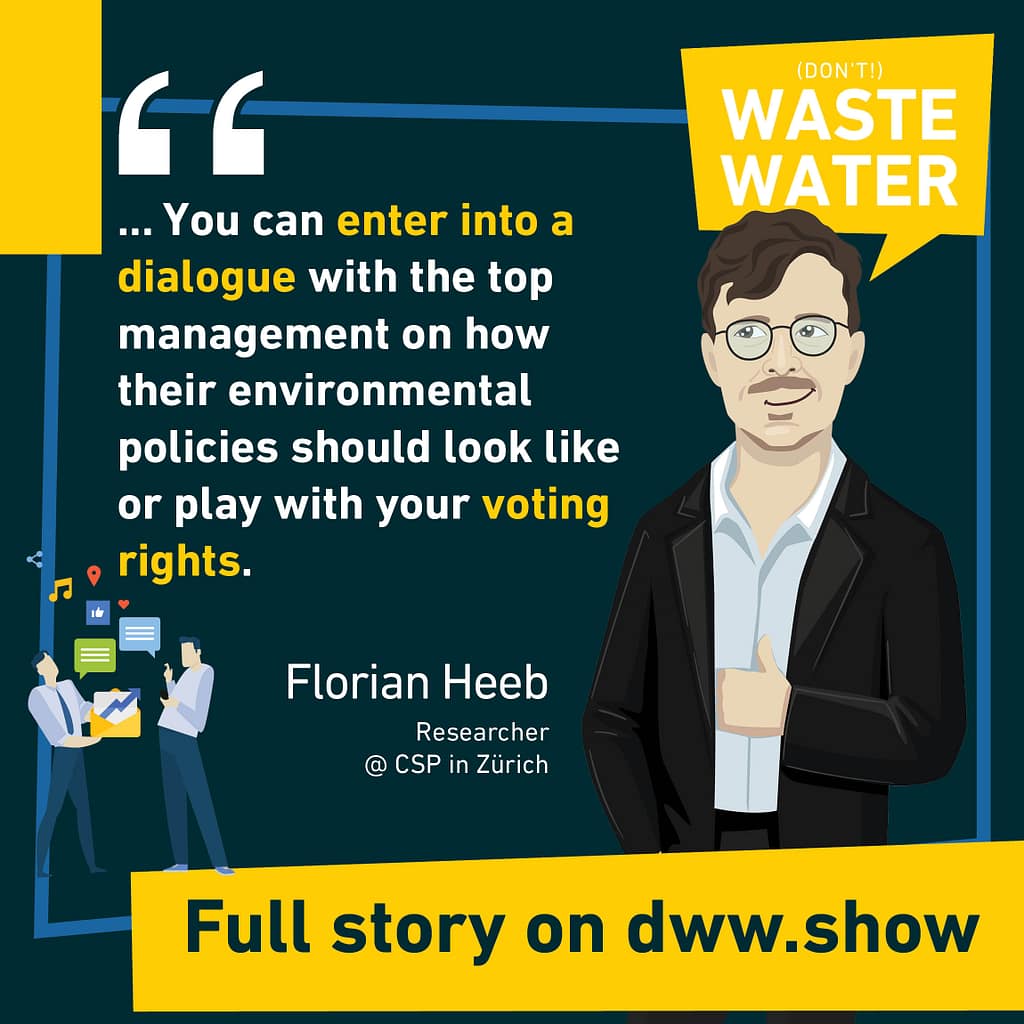
There’s no way they can grow out of that. And even now, you know, there’s innovation, smokeless smoke and, and these things which may have merit I think it’s claimed, I think that they are causing cancer less, or maybe not at all. Maybe it’s even healthy. I don’t know,
But I haven’t seen a single sustainability fund who says, well, okay, now we accept tobacco. I think that the screen is still there. So I’m not sure how, you know, does this incentive really work, especially for the big tickets, right? You think about fossil fuels, you think about, tobacco, it’s more on the, on the small improvements. I think that’s where I see it working more.
Is “step by step” the path to victory?
Antoine Walter:
So that’s what I understood reading your paper. You can have more impact if you’re aiming for a company to change something, which is not very costly. So it speaks a bit along with what you said before, which is that we should not aim for perfection, but to do a bit better. And if we do a bit better, step-by-step on the long run, you achieve it.
But if you go directly for the big step, you just don’t have enough of a lever to make it happen. Regarding these appreciation depreciation, is it exactly working the same way for appreciation and depreciation, or is one of the two directions easier or more efficient to leverage?
Florian Heeb:
Hard to say! I would say, I would say, generally speaking, that’s it’s the same effect, but I think what’s always important to consider is, as Julian mentioned, if many investors go out of fossil fuels or let’s say tobacco, I mean, eco shares drop, and there is kind of evidence that there are lower. So currently, because many investors share kind of set that preference or rule.
Let’s take Tesla. If everybody wants to buy Tesla, obviously, share prices, go up a bit. But the problem you always face is that’s not for free. So if you’re an investor and you see that many investors invest in Tesla, just because they like electric cars, then it will drive up, share prices way beyond fundamentals so there will be a lot of analysts being there saying, “Now Tesla is overvalued, so we’ll sell.”
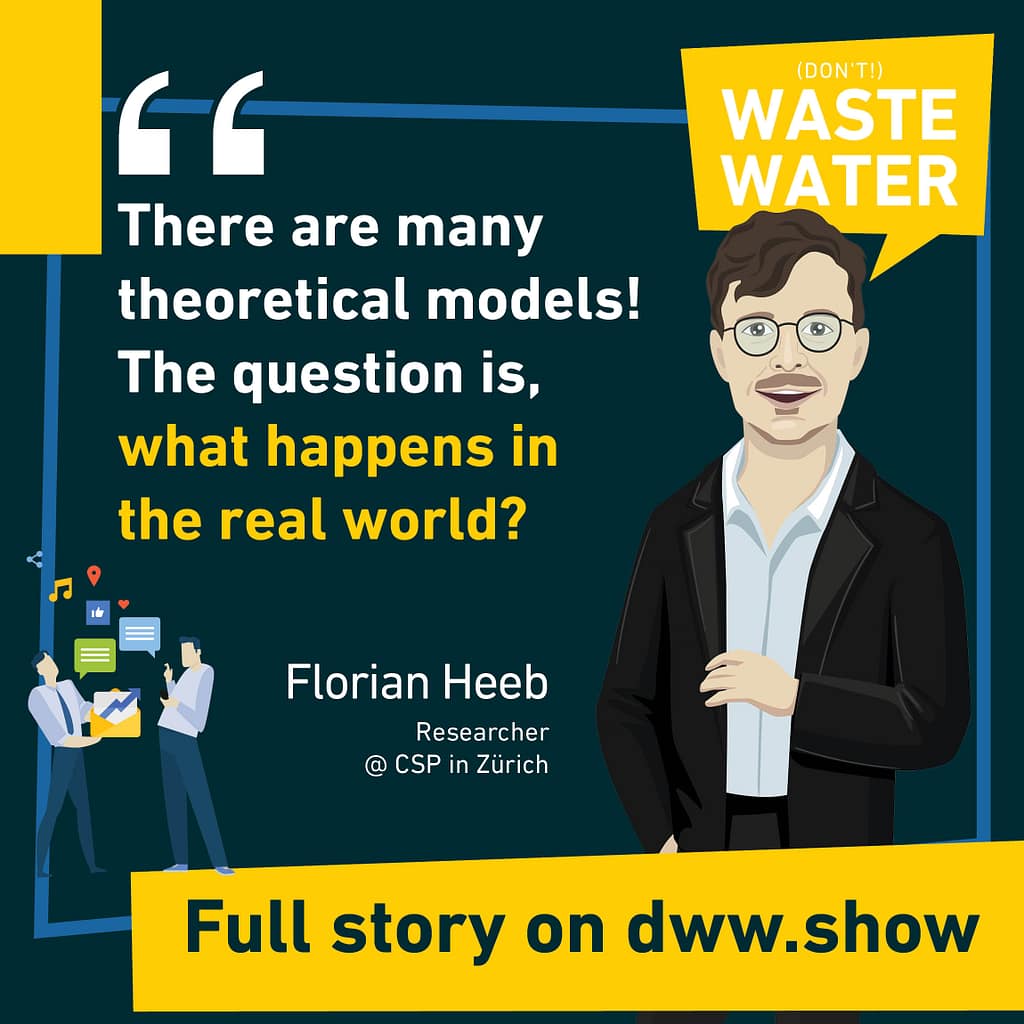
So I think that’s an important point to see about these public stock markets. There’s always, as soon as something drives up prices, little bit, you know, there’s a opportunity for arbitrage also in the other ways around it, as soon as, you know, something drops prices.
For tobacco, there are sin stock funds. They perform pretty well because of that because many investors have this taste. So share prices are a bit down. So you get them cheaper than what fundamentals would actually kind of demand from such stocks.
What is the strength of Impact Investing compared with Sin Funds?
Antoine Walter:
Which brings the question of what’s the size of sustainable investment compared to the overall finance market, because if there are green-minded funds and, and sin stock funds, how do they balance? And, in your paper, you cite a number of 30 billion us dollars for the overall sustainable investing. Is that the right figure?
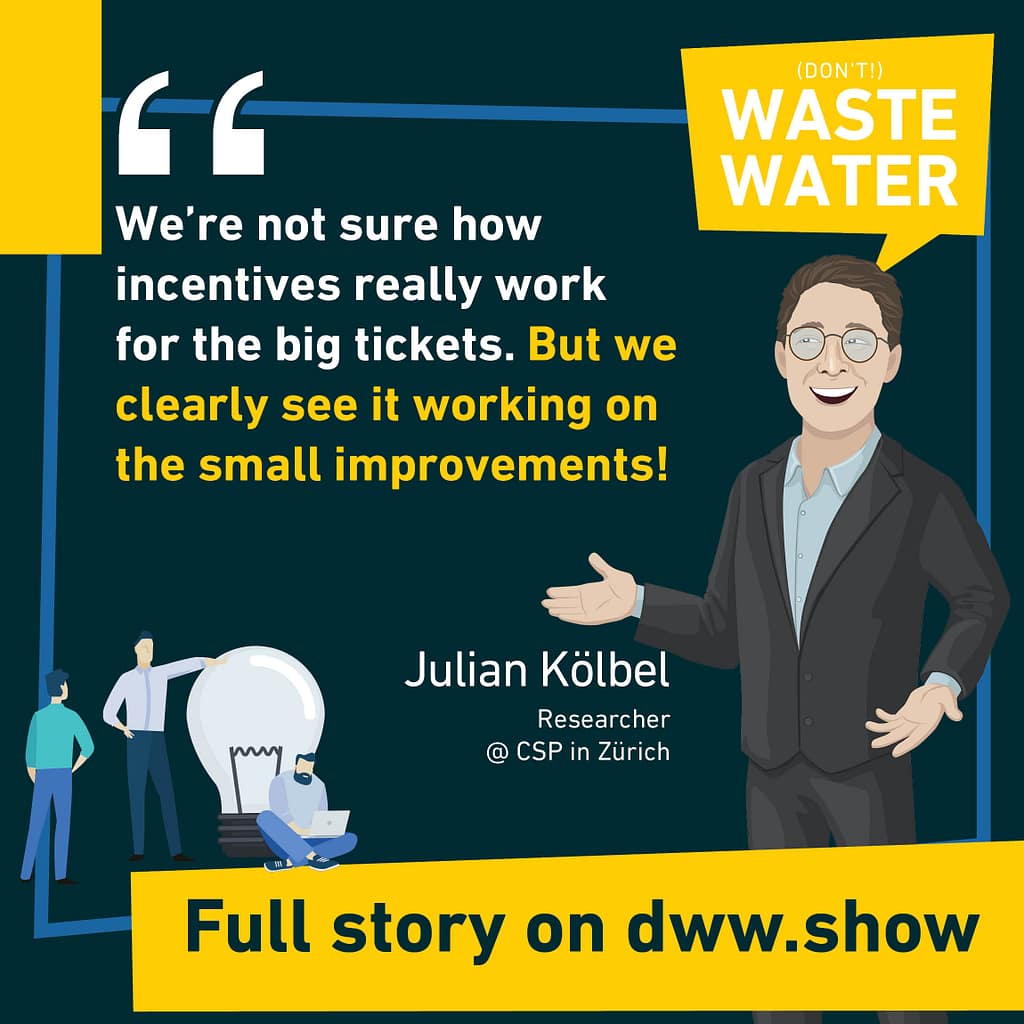
Florian Heeb:
I think it’s 30 trillions. You have to add three zeros, which is an enormous sum to say, but then again, I think we, as, as, as we discussed, I mean, that’s a very, generic thing, sustainable investing.
So you have to look into details. What do these, these, these products actually do.
Sustainable Investing Vs. Fossil Fuel Subsidies
Antoine Walter:
Okay. 30 TRILLIONS changes the picture because I was really shocked. Sorry, I misread that one because, I was comparing this number with the about 300 billion us dollars, which are spent in supporting the fossil fuel economy one way or the other through various policies. I was thinking if that’s still 10 times higher, but it’s not 10 times higher. If I get it now, you will know your new number, right. It’s 100 times smaller, so good news?
Florian Heeb:
Good news. But at the same time, what, what was the number? You mentioned four fossil subsidies?
Antoine Walter:
According to the international energy agency in 2019, we had 320 billion us dollars of support to the fossil fuel economy, which is down. It used to be more, but still, it sounds almost anachronic, you know, in 2021 to see that we still have 300 billion of subsidies to that sector.
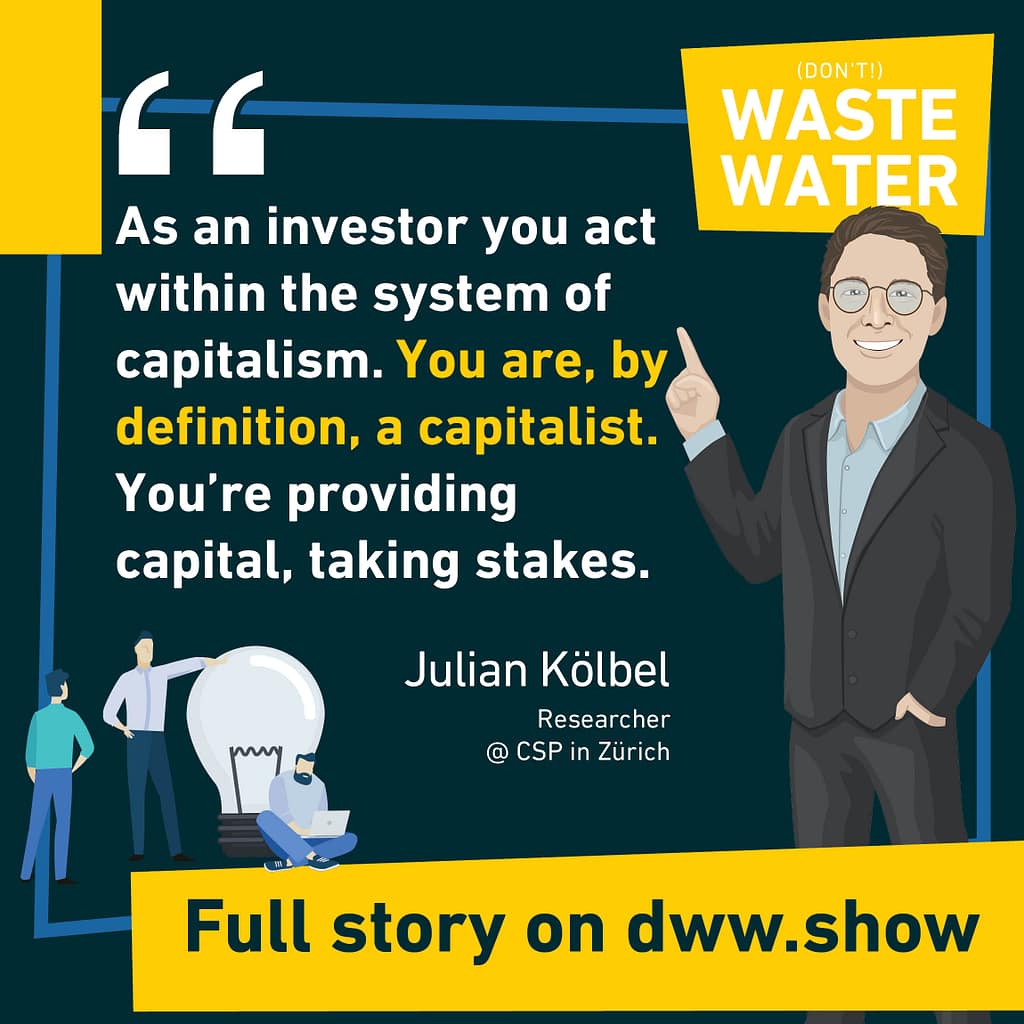
Florian Heeb:
I mean, if you look at this global numbers, the same report for every half, these 30 trillion of sustainable investing from, if you look at the amount of impact investments, so really investments with the aim of reaching impact, of growing small green companies, that’s only something like 450 billion. So that’s interesting to see, I mean, that kind of money actively trying to grow green companies is maybe counterbalanced with money, actively trying to keep the fossil fuel industry alive.
Antoine Walter:
You were mentioning the risk and you were mentioning ESG to be driven by risk, but somehow, disrupting the way you look at a market, such as transportation or energy or water is also a risk for the economy. So I can understand that there are activists or sustainable or impact investing on one end, but there are also people that say, “Hey, I hate disruption. I want things to be steady. And as they were, because that’s a safe investment”,
I think that’s a discussion I had with Nicola Lei Ravello on that microphone. We were saying that if you’re a pension fund, that the last thing you want is to have a risk that the pensions of a full country get disrupted because you invested in the sector, which is going to vanish. So yeah, I see different forces which are at play and that might be playing against each other.
Sustainable Investing can not save the World alone!
Julian Kölbel:
On that point, I think we want to draw a real clear boundary about what, what types of impact you can have as an investor in principle?
I think the thing is, as an investor, you act within the system of capitalism, you are, you know, by definition a capitalist, right. You’re sort of providing capital, you’re taking stakes. Right. So you’re working within the system and that’s why we say, well, you can achieve a lot of incremental changes as an investor and you can accelerate them and they are valuable.
But there are some issues that require political change. You know, there’s not a commercial solution for every problem. We have definitely not. There are many commercial solutions that thrive on wrong incentives that are politically generated.
And I think, you know, when we think of carbon emissions, I think, you know, there has to be a regulatory response. Sustainable investing cannot stop climate change on its own. It can help, but not on its own.

And so, so sustainable investing plays within the system with perhaps one exception. I thought about that because of the fossil fuel subsidies, right? We say, you know, divesting tobacco or fossil fuel stocks, we’re unsure about the impact there, because the incentive to change it’s hard to make a case for that.
But if the university of Cambridge for instance says, “okay, we’re out of oil”, which I think they did, they said recently it’s also a political message. It is a message that this leading world-leading university has concluded that this is a sector that’s somehow inconsistent with the future of the university and that they are committed to building a future that looks very different.
And then all of a sudden, if the university of Cambridge says that it sort of moves the goalpost, so it’s not a crackpot idea anymore to say, well, you know, the future is going to be very different. You know, now with the University of Cambridge is saying that, and also maybe an insurance company, you know, insurance company, or a pension fund is saying that, so it is also political.
And we see, these proponents of fossil fuel divestment I think they themselves concede that they know there’s not really an economic effect, it’s a political tool you know, to generate attention and also to hopefully bring on the way regulation that then ultimately has an impact.
Third mechanism of Impact Investing: Activism
Florian Heeb:
I think that’s exactly the third mechanism that we didn’t discuss yet that you mentioned in the beginning. And I think to sum a bit up, you, you ask about, you know, what can sustainable investing, do.
We see three different things it can do, and each has its limitations. You know, first of all, you know, investors can grow green companies, but it’s limited to two small companies, emerging market financial frictions that’s not, you know, the big bulk of the money, but, you know, a small portion of money can, you know, change very specific things locally and have, have a huge effect there.
But that’s not going to change, you know, the large world economy then there’s, you know, we said investors can make companies greener, but then we also say, but that only really works if you aim for, you know, small step-by-step improvements.
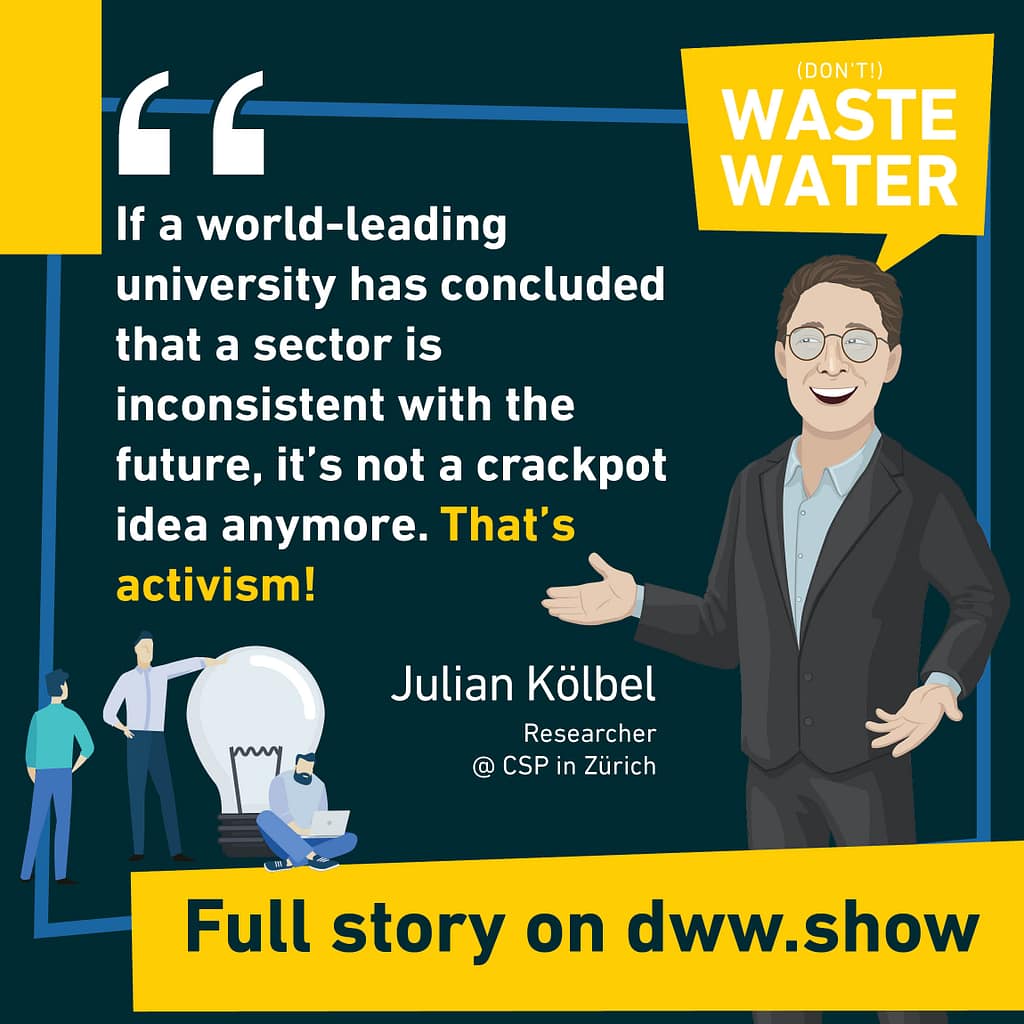
So if many investors do that and push for that, that’s going to move the needle, but it’s not going to cause a transformative change. We need to go to net zero in 2050, for example.
And then we say, I mean, even by, for example, divesting from certain industry, even if it doesn’t really directly affect these industries that can, you know, affect the political discourse. But again, that only works. If you were aware a very public, you know, if you do your announcement very publicly if you’re an investor too, that has some, you know, some standing in the public to start with.
Finance Activism can trigger Regulation Changes
And I think if you take that all together, I think it really sums up that sustainable investors can do a lot to move in a certain direction, but they cannot solve problems on their own. They need regulation.
I think this is something we increasingly see that this is a very crucial topic. And you, you ask about the pension fund. I mean, the interesting thing I think is a pension fund has, you know, maybe every average beneficiary has to wait 30 years getting his money back. So they have a long-term vision they’re usually diversified.
So basically most pension funds that invest in the world economy maybe are you’re overrating, local economy, but, you know, so such investors would have all incentive to solve complex problems. So, I mean, they would have all incentives to stand in for tougher regulation for the current price. Because I mean, looking at the science, we know that we all would be better off in 30, 50 years, if you have tough regulation now or stringent regulation.
And I think this point at, you know, that the investors could have a very stronger voice in demanding stringent regulation of complete problems or freeriding externalities, for example, climate change.
… “Brown Companies” already do it!
And I think that’s a huge thing that could change. And also, Julian, you mentioned this divestment movement. I think there’s unfortunately a movement on the other side. I think there’s a lot of political lobbying of current fossil companies to stop environmental regulation.
Switzerland just lost a public referendum on the CO2 law. And there’s many reasons why it’s this population reject the laws. But I think it is striking that the referendum itself was launched by a kind of an industry association group, which was dominated by fossil companies.
Here, investors are the owners of companies, these pension funds own a lot of, these fossil fuel companies. And they cannot just tell them, you know, keep the oil in the ground that bumper, but maybe investors could demand from, you know, these, these incumbent companies that have to change this stop lobbying against required regulation.
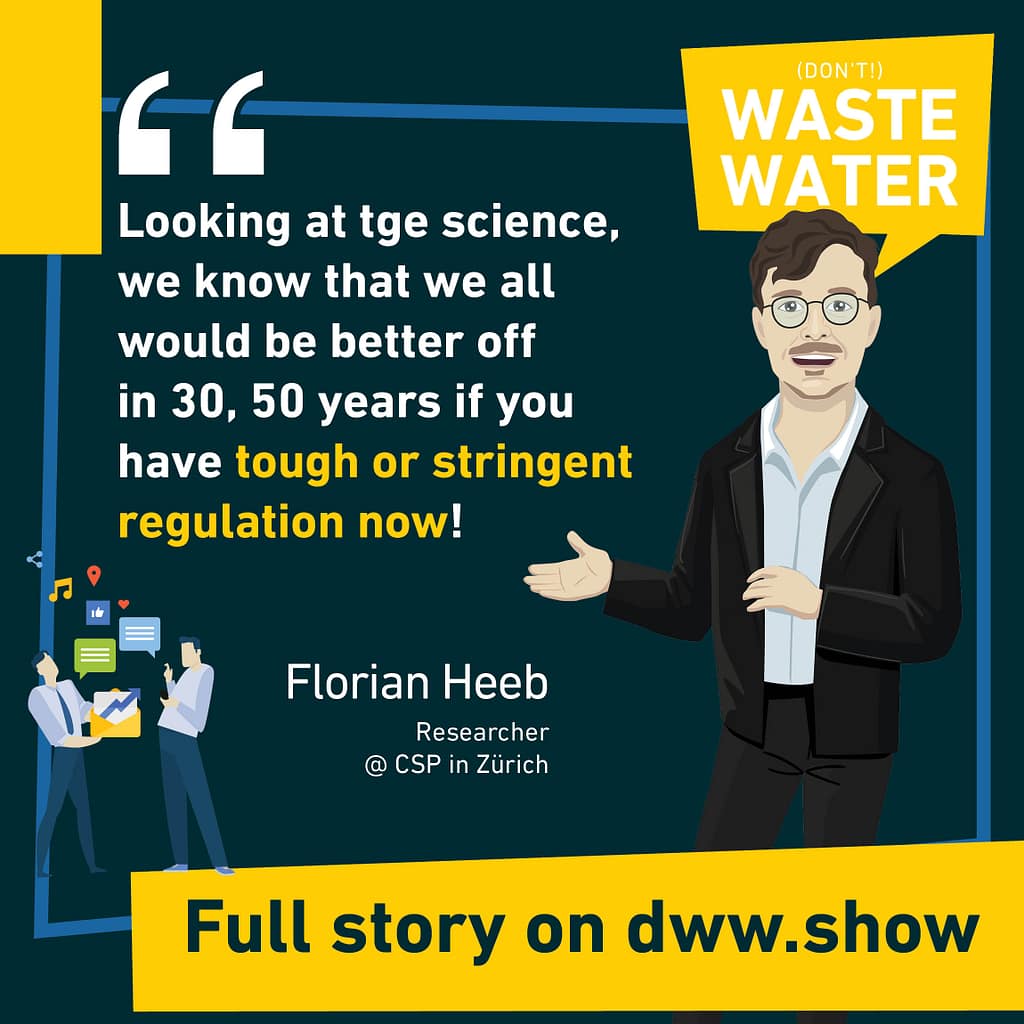
Antoine Walter:
There are many elements in what you just said. First I love the irony of discussing with finance researchers based in Zurich and explaining to me that we should be illiberal that’s the market cannot regulate itself. That was really just to be the devil’s advocate.
But in your paper, you also show how if you’re a company in a sin industry, there’s not a strong incentive to do yourself a bit better because your industry itself is still going to be seen and cursed to be the bad guy. And the third element is something that was very interesting in the sustainability puzzle, which is the book from Alice Schmidt, an Claudia Winkler, because they show how, if you have system thinking and you just zoom out, all of this makes sense even for an oil and gas company to say, if I look at the bigger scale and I look on the long run, I will have to change.
But if you, if you keep being narrow-focused on what you’re doing currently and for the next five years, then, of course, there’s no strong path to victory in the change itself. So I’m not going to sidetrack fully the discussion to say, is it the limit of the Swiss democracy system to ask the population for long-term vision when it’s more, it’s probably easier to explain why the arguments are good for the next five years.
What is the strongest mechanism Impact Investing can use to do good?
So not going to sidetrack here. But we have these three mechanisms which play their role. So give capital to this green company, make Brown greener or this activist element of being going into indirect direction. What is the strongest one? If you have to pick one?
Florian Heeb:
That’s a hard question because mainly because they do entirely different things and are really hard to compare. So it has to be a mix.
Julian Kölbel:
You know, as a finance guy, I would advise diversifying over these three mechanisms because all of them are uncertain, right?
I mean, that’s serious if you’re, you know, if you want to have an impact as an investor, let’s say you’re a private person. And you are fortunate to have some savings and you want to invest them in a way that you don’t want to sort of completely lose them, so you don’t want to do charity and just give them away.
You want it to be an investment for your own future, but you also want this investment to have positive side-effects on the world. Then I would exactly do these three things. I would start with growing green companies here is a question of how much risk are you willing to take.
Finding the right Impact Investing mix
This is something that’s not super easy to do because you sort of have to look for specialized providers and it’s risky because these are small, you know, businesses that might go bankrupt or they are in countries that might just sort of collapse politically, and then your investment is gone. And so you have to be aware of that and decide how much of my portfolio am I willing to contribute to some sort of risky bucket.
And then you can go with that risky bucket and look for the most convincing products out there, or even do direct investments. And then with all the rest, which is probably going to be in public equity, bonds, maybe land and metals, you know, but, but for the, for the stuff that related to companies, I would try to find a fund that has as an institution, a convincing approach to engaging with companies, sort of push for change and also very clear kind of framework on what is it, how they assess companies.
So to make both effects work like both the sort of the voice effect, but also then the sort of exit where you say, well, this is, you know, this is the red line. If, if you don’t achieve that within three years where we’re simply out.
Sort of some an institution or a fund that’s sort of really hits this effect. And ideally they even themselves know how to explain how they are impactful. We haven’t seen a lot of funds that do that, but I hope that they’ll get there soon. That’s what I would do with all the risks.
And then as a third thing, I would, you know, think about who am I, who listens to me, and tell people about what you’re doing with your investments and why. That may be your family. That may be your workplace. I don’t know who that will be. Maybe you are very famous. You know, if one of these, like if Cristiano Ronaldo did this, I think it will be extremely impactful. So I would use the third channel as well. According to your means, obviously.
Florian Heeb:
Yeah. I mean, basically truly what you’re saying is, is if you look at how most portfolios of investors are structured, it just makes sense to do everything you can, and then to diversify because you have, you know, very risky, small investments, very small buckets, and you have all these large companies in there anyhow. Capital allocation is maybe not the thing to go, but rather change.
Is Finance sufficiently supporting the Water Industry?
Antoine Walter:
Let me suggest you a last section in this deep dive, to put back my, my water goggles, my water hats. I was looking for the numbers in terms of, of money that flows to the water sector. And I found contradictory sources, but still, it will give us a, an order of magnitude in his Ted talk Sonaar Luthra, which is the CEO of Water Canary was saying that about 0.12% of the early VC investments, early VC money goes to water, citing a CB insights source for that.
I did my own calculation with BlueTech research numbers and the OECD numbers, and it resulted in 0.7% of money, which goes to the water sector.
So my interpretation of that would be to say that there’s not that much of the first pillar you were citing, which is pushing these green companies, which are emerging.
And on the other end, we have the finance market and the stock market for water, which is quite high right now, which means water companies are expensive on the markets, which sounds to me like the financial sector would say, Hey, this is resilient. This is sturdy, and this is going in the right direction. Let’s invest in that.
So is it another simplification to say that generally speaking, the finance market is not playing that much on the first mechanism for the water industry and quite a lot with the second lever? And do you think there would be chances to move a bit the needle and to push a bit more for investing into early-stage water companies, which might be able to solve issues like SDG6 or SDG9, or SDG15?
Better leveraging the “Make Green Companies Greener” mechanism
Florian Heeb:
Hmm. Good question. I mean, I have to say, we just did a research project together with a Water Accelerator called Seevas. So this was our colleague, Tim Kwan, exactly working on the topic. They work with startups mainly focused on middle east and other countries, which we could classify asnot perfectly working capital or not perfectly efficient capital markets how these startups could scale.
And they usually, they face a lot of problems receiving finance, kind of working on the reasons why and how that could change. And certainly I think water startups often do not have, you know, an easy start because often, you know, they, they serve populations that do not have, you know, a high ability to pay or, you know, they work in certain government with tricking things or working large infrastructure. So yeah, I think that is, I think this is a huge topic in itself, but certainly, I think there could be much more investment there.
Julian Kölbel
I think water is an example where capital, I’m not sure if that’s the bottleneck for, for that sector to get ahead. Right. And sort of water is just the ultimate common pool resource. And that a lot of what happens is just really dependent on how it’s regulated. And the price of water is absolutely central of course.
You can invest and bet on an increase in the price of water, you know, in the US with water rights, you can do that in other places potentially as well if you invest in a utility, but there’s always this big political game around, you know, where should the price of water really go.
Because then if it goes up, then the investors cash in and yes, people will start conserving water, but also there’s going to be an crazy political backlash from all sorts of constituencies who say, well, Hey, you know, we need water and politically, that’s a pretty powerful message.
So I think personally the water sector is a really difficult one to, to invest in. I think there are probably very good opportunities. There are definitely, we need good solutions. But I think without progress on the regulatory and political front we’re going to see the same problems that we’ve seen for the past decades simply continue in many ways. I think it’s, you know, there is a case for water saving technologies especially in agriculture but in the places where there’s little water that has been, you know, it has been implemented to a large degree already very often.
Is it possible to scale innovation in the Water Sector?
Water is a really hard sector to found a successful startup, right? It’s if you, if you think about who you compete with, you compete with people who sort of invent Skype the next Skype, right. Sort of it’s a bit of software and you can scale to billions of people. You never have this, I think with water, like it’s always very local. It often entails sort of investment in infrastructure. That’s you know, all that makes it really difficult to find a startup in water, and that makes it not attractive to the to the venture capitalists.
Antoine Walter:
Is sorry, because if you look at infrastructure, the way it’s done, I’m fully with you fully agree. Now that has been, endemically grown from what the Romans and the Greeks have been doing millennial.
But we could be having something fully decentralized. I mean, I had on that microphone, for instance, Navkaran Singh Bagga, who is the CEO and founder of AKVO atmospheric water generation systems. And that’s just an example, not to say that that is the solution for, for everything, but if you’re in a tropical zone, which is about a zone where 3 billion people live in the, in this world, you have good conditions to generate water from the air, wherever you at about 10 times less money than both of the water. And there’s at any time in the air about 1.5, the Geneva lake of water. So that is a fully distributed solution.
And he is looking at a way to do it as a service. So you could be imagining to have a rapid distribution of his machines or similar machines, really not doing Navkaran’s advertising but he was a cool guest to have to put him in between the light. And that means that you could have this path to hypergrowth.
Hypergrowth again! An hidden gem of Impact Investing?
That’s certainly possible because you invest you burn money because you put your devices everywhere, and then you run them as a service. And then it’s, it’s not Skype. Sure. There’s still a hardware element in it, but it has similar patterns to how the word of SaaS were works today. So, sorry, I didn’t want you to, to get you off here.
Julian Kölbel:
I think that is a beautiful example, you know, for a potential impact investment. And of course you would have to sort of look at that in the detail. Could it really work before you commit your money to it? But I think that’s what we would love to see is that there’s broadly in the population.
There’s a lot of people who want to have some impact with their money. And I think it could be very powerful if they said, well, okay, 1% of what I do is going towards something very risky, like this water capturing project. If no one has ever tried it before. We honestly, you know, it’s uncertain if this will pan out, but we’re willing to risk our money to see whether it works out, right. Because if no one does, you know, it will never see the light of day. And that would be great if more of that would happen.
Regulatory context needs to help (and incentivize)
Florian Heeb:
But I think again, I mean, coming back through regulatory environment, I think Julian, you already mapped it out for water, that’s really local and really, you know, patchy. So I think that’s, that’s the interesting thing about climate. I mean, there’s like a whole boost of climate startups. I mean, it’s very, because I think that the global regulatory environment is, is at least moving in the direction where, you know, you can be rather certain that you’re going to get paid to some extent for reducing carbon emissions.
Voluntary carbon markets are, are skyrocketing. You have emission trading systems popping up. So, I mean, there’s kind of, it’s obviously the same, same problem. If you do innovation and startups innovate where you solve externalities, in some ways somebody has to pay. And so here, of course, to a certain extent impact investors can jump in and say, okay, I’m going to accept, you know, lower returns, high risk, but they’re not going to change the fundamental problem.
You know, solving water is a common pool. So a willingness to pays off, not that high. So, but, but there, I think the coop, I mean, there is interesting, you know, financing mechanisms talk about results-based finance. So which we basically have with car markets. I mean, if you have a good project that reduces CO2, you can get, you know, finance by that could also be using the water sector.
Our colleagues at for example roots of impact, they’re pioneering, what they call sink. So, you know, outcome specific payment, looking for payment contracts with companies that achieve, you know, some milestones and they have applied that to the wastewater sector, for example, with the same logic. I think it’s in some developing countries nobody’s willing to pay, or the government is not willing to pay yet for the service, of cleaning wastewater.
Impact Investing can jumpstart initiatives for governments to then carry on!
But in a few years likely that that will be the case or in future. So jumping in it’s often development financing, corporations that jump in and say, okay, we’re going to pay you for that externality. We pay your price per you know, could you be commuter of treated wastewater contractually over the next 10 years?
And once you have set up debts and have set up a system and have, you know, run a successful business model, this, you know, dif getting paid for the externalities, it’s much more likely that the government will jump in later on and then really pay for, for solving that
Antoine Walter:
It’s some of coming back to this topic of risk, because you could, I mean, look at the international space station, they work with one glass of water per day. So you could be solving the full water scarcity problem on earth by just saying let’s reuse everything.
Of course it is by far not economical, so it’s not going to happen, but you can move a bit the needle. So it’s beats more economical in some regions. And that way, what does cars do you get somehow mitigated because you reuse on several passes, the same water.
I could keep pushing for another few hours here on that topic. But I’m cautious of your time. What I can propose to you, nevertheless is I had double the question then the one I asked for this first paper, whenever you publish your next paper, this microphone is open to you anytime. So if I wasn’t scaring you too much with my stupid questions, consider it’s an open invitation, and happy to have another conversation. So I propose you to switch to the rapid-fire questions.
Rapid fire questions:
Antoine Walter:
So in that last section, I’m going to try to keep the questions short and that if you can keep the answers short as well we will have a back and forth, and don’t worry; I’m the one who sidetracks all the time. My first question is what is the most exciting project you’ve been working on and why?
Florian Heeb:
I mean, for me in our common work, with Julian, it’s certainly our investor’s guide to impact, because it really enabled us to take like four years of research putting in into a very visual way. And I’m really happy that the resonates with many practitioners. if you be saying, ah, no, that makes it clearly understandable, like a very complex topic. So it really moves the conversation. I’m really happy about that.
Julien Kölbel:
I completely agree. It’s that work on investor impact because somehow we addressed this big question, you know, what, what does that sustainable investing trend really do? And I don’t think we have all the answers of course, but, but we have some, some good ideas and, and that was really nice to also then pass on these ideas to lots of people who really care about this and appreciated that we put the work in.
What’s your favorite part of your current job?
Julian Kölbel:
It’s actually well, the best thing is to think with Florian about the next thing that we would like to do. It, contrasts nicely with the things that we’ve already signed up to do, that we have to finish. So, but talking about the next thing is my favorite thing.
Florian Heeb:
Completely agree. Yes. It’s catching out the big ideas.
What is the trend that you see, which we should watch out in the water industry?
Florian Heeb:
I think there will be a lot of development in innovative financing mechanisms to tackle water issues. That’s something I’m really curious about, but here our colleague Taryn Kwan could be a really interesting person to talk to.
Antoine Walter:
Thanks for the suggestion. It’s interesting that you mentioned that because many of my guests have mentioned that we have to be innovative with the business models and the way we look at that part of the market. And the other side of that same coin is that we are an industry that is full of water engineers. So we are probably not the best to come up with innovative ways to finance and to have clever business models.
So there’s probably some synergies to find here.
What is the thing you care about the most when you start on a new project and what is the one you care the least about?
Julian Kölbel:
So one thing we figured out would be good at the start is to think about what is a misconception that is severe in terms of its consequences and many, many people have it that we can rectify, right? If you can do that as a social scientist, I think you have real impact in the truest sense of the world that you change the way, like, sort of changed the way people think about problems in a good way.
So, that’s something we care a lot about and the least… I couldn’t say what I care the least about, but, but this is the thing we focus on. And then the rest is after that,
Florian Heeb:
I would agree.
Do you have sources to recommend, to keep up with the latest trends?
That’s a bit of advertisement in our own, you know, have a look at our investors guide to impact, have a look at our paper titled “Can Sustainable Investing Save the World?” reviewing the mechanism, goes off investor impact. That’s basically what we discussed today. I
On the CSPs homepage, we always publish our latest research. We have a medium blog. Very, we kind of have more kind of, you know, opinion pieces on where things are going or could go.
Antoine Walter:
It’s a very interesting race that I would really advise to the people listening to this. Doesn’t get sufficient collapse in my opinion. So if you’re on medium, just give it a look. I’ll put the link in the, in the, in the show notes. And I think you somehow already cracked it, but…
Would you have someone to recommend me that I should definitely invite on that same microphone?
Julian Kölbel:
Well, we would warmly recommend our colleague Taylor Kwan who has done research product into how water entrepreneurs and impact investors find together or not. And I think she’ll have a lot of interesting things specifically for your show. That’s the main person I can think of!
Florian Heeb:
Maybe also, I think it would be maybe interesting to, I mean, this, she does a large project together. If this save authority mentioned key accelerator of water startups. So maybe you could talk to them trying to, because I think we now gave you a Roger, you know, top level view on impact and financial markets.
The people at SEVAS, they’re much more concerned with, you know, kind of the daily struggles of real life, you know, startups in the water sector. So they have a completely different perspective. I think that’s, that’s really interesting.
Antoine Walter:
but really your point of view was very interesting in the sense that we see quite often the one industry as a silo working on its own. And it’s good to see that we are not alone in this world. There is a number picture, and as much as I keep repeating on that microphone, that we’ve never seen a water unicorn never happened.
We’ve never seen an environmental unicorn neither. So sustainability is not really doing much better to that sense than the water sector. And probably there are synergies to leverage. I mean, there are so many clever Ideas in energy, which you could transfer it to water or in transportation or in climates that you could just apply in water instead of reinventing the wheel all the time.
So that was at least for me. Very, very interesting. So thanks a lot for your time, both of you. And as I already said, but I stand my point. Whenever you publish your next paper I have at least half of my questions about the previous paper, which I can still ask you. I’m sure I’m going to have double the ones for the new one.
Last thought? Let’s create a Water Impact Investing Fund!
Julian Kölbel:
It was a pleasure discussing would be our pleasure. Definitely. I just, if I may, because I’m now product to think about how can you have impact in the water and a little bit from this general question, you know, there are these water funds that are sort of thematic funds where you say, you know, in, in there, there are water utilities and water tech companies and also beverage companies.
And I think Florian and I were both maybe that’s not the most straightforward way to go about saying, okay, I want to make a difference in the world of water. Because the criteria, whether you’re included or not included in the fund is sort of pretty binary, right? Sort of either you fulfill the industry classification or not. And then it is the capital allocation case, which is also difficult to make given that these are large companies, but what I would find very interesting is a fund that says, okay, we focus on because water is relevant in most industries that have any reasonable operations, right.
So you could have a fund that doesn’t do ESG, but really sort of focuses on, you know, how does a corporation deal with water? Like, you know, what are the processes for, for internal reuse? How do they avoid dangerous chemicals leaking out? How do they collaborate locally with the community? And I think most importantly, how do they onboard innovative water technology? Because that’s usually the thing that makes the life of a startup, if you, if you make a deal with the corporate to say, you know, we’re buying a hundred units of your thing and sort of integrating them
So so a fund that focus on that sort of, you know, integration of new water technologies in big corporation sort of, you know, could do engagement on that front, to facilitate that and also scores companies on how good they are with that. I think that would be really interesting. I haven’t seen it, but I think that’s something to maybe think about in the wider community of water professionals to work in that direction. So what I find, that’s not a thematic water fund, but a sort of good water practices fund across all industries.
Florian Heeb:
So you’ll see, that’s exactly the kind of ideas we like to discuss and sketch out. But really at sometimes maybe we have to start one of these funds.
Antoine Walter:
So next time we discuss, we discussed about your water fund and I love the pitch that you just made. So if someone listens to that and wants to to act on the promise, just, just contact me, I’ll be passing it over!













7 thoughts on “3 Powerful Tactics Impact Investing shall better use to Save the World”